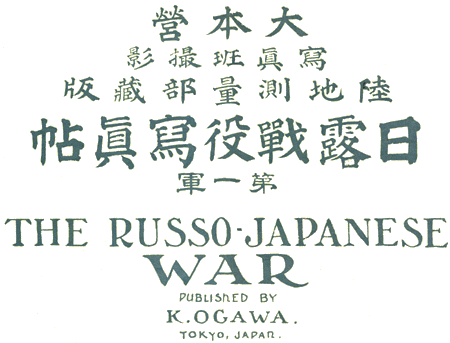|
Military Survey Department
Ogawa Kazumasa (Halftone Plates):
The Russo-Japanese War, Taken by the Photographic Department of the Imperial Headquarters, Army Parts 1-23, Tokyo, publisher - K. Ogawa, agents - Kelly & Walsh, "Copyright 1904, by The Military Survey Department," large oblong 4to (15 x 10 3/8 in - 38.4 x 26.4 cm), stiff red or charcoal gray paper wraps with silver lettering (Japanese an English) on front and black decoration on the back, two stab cord ties, spine covered, published on a monthly or semimonthly basis during Meiji 37 (1904) and Meiji 38 (1905), collotype plates, no text pages, reads Japanese style from back to front. All printing is in Japanese and English.
The parts each contain a title page, a "Contents" page and individually numbered collotype plates printed on one side of the plate only. On the average each part has 28+ plates. The plates have detailed captions in the margins. Some volumes contain unnumbered collotype plates immediately after the listing of plates ("Contents") page. These plates have images of high ranking officers. The unnumbered plates are not included in the "contents" list. This is a deluxe printing (collotype rather than halftone) of the plates that are found in the hard bound editions of this series that were published later. The plates are thick non-glossy paper with high quality collotype reproductions of the war images.
Some plates have a tissue overlay which covers the entire image on the plate. The overlay is hinged (glued down at the top) and can be lifted up to see the image below. The overlay highlights topographic and, in some cases, military dispositions which are shown in the underlying image. All lettering on the tissue overlay is in Japanese.
These volumes were advertised by K. Ogawa in the Kokka, #182, July of 1905, where he advertised "Photographs of the Russo-Japanese War...13 Volumes Already Published." Each Volume was priced at 2 yen (collotype) and 60 sen (halftone). The collotype volumes were priced 3.5 times the price for the half-tone. I find the collotype versions very rarely enter the market. Even the individual volumes of the half-tone plates are seldom seen. Rather, these items are generally found in hard bound formate in either 2 or 6 books.
Based upon the Ogawa advertisement noted above, it appears that these individual volumes were published in halftone as well as collotype. However, I have only seen the halftone plates in the bound volume format.
A two volume hard bound set consisting of 27 numbered parts (23 Army and 4 Navy), 787 black and white half-tone plates (Army, 660+ plates - Navy, 120+ plates) was published ca 1905. Of the total 787 plates, 15 are foldout and 19 have tissue overlays with Japanese language descriptive titles. Each part has a title page, listing of plates and ends with a colophon. All plates have Japanese and English descriptive titles on the plate. The plates are generally printed front and back. The volumes read from back to front in Japanese style. This two volume set contains no text pages. I believe that the collotype volumes contain the same images/plates found in this two volume half-tone set. Information of this two volume set is here.
These images are also found in a bound 6 volume set with half-tone plates. That set contains additional plates as well as text sections. Information on the six volume set is here.
The collotype plates are much higher quality than the halftone printed plates. Below is a side by side comparison of the two types of printing.
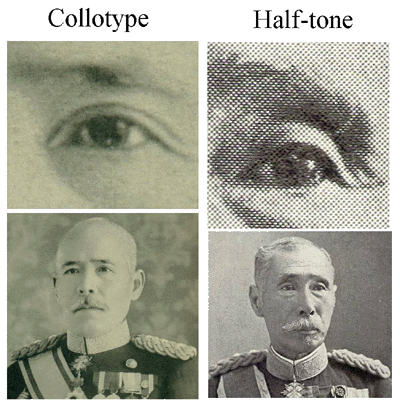
Each Part (volume) is dedicated to a specific Japanese Army. The plate numbers run consecutively, by Army, through the parts. In other words, the First Army plates are numbered 1-90. The Third Army plates are numbered 1-224.
Here is a breakdown of the parts relating to the First Army and the Third Army.
Part:
Nos. Year/Month Published
Vol V First Army, Part 1, plates 1-30 1905, January
Vol VI First Army, Part 2, plates 31-60 1905, February
Vol XVIII First Army, Part 3, plates 61-90 1905, August
Vol VII Third Army, Part 1, plates 1-27 1905, March
Vol VIII Third Army, Part 2, plates 28-53 1905, March
Vol IX Third Army, Part 3, plates 54-79 1905, April
Vol X Third Army, Part 4, plates 80-107 1905, May
Vol XI Third Army, Part 5, plates 108-133 1905, May
Vol XII Third Army, Part 6, plates 134-162 1905, June
Vol XIII Third Army, Part 7, plates 163-191 1905, June
Vol XIV Third Army, Part 8, plates 192-224 1905, July
I only have personally examined the 11 parts listed above (First and Third Army) and they are recorded on this web page. The parts average 28+ plates each. Using that figure and the number of plates found in the two volume set with half-tone plates, I believe that the complete set of the 23 volumes/parts (Army) with collotype plates looks like this:
Numbered Plates*
Parts 1-4 Second Army for a total of 112 plates
Parts 5-6, 18 First Army for a total of 90 plates (confirmed)
Parts 7-14 Third Army for a total of 224 plates (confirmed)
Parts 15-17 Fourth Army for a total of 90 plates
Parts 19-20 Second Army for a total of 60 plates
Parts 21-22 Karafuto Army for a total of 56 plates
Parts 23 Yalu Army for a total of 23 plates
Total number of plates 655 plates
* Some volumes also contain unlisted/unnumbered plates (generally 2 or less) at the front.
It is also likely that Parts 1-4 of the Naval book were published for a total of 117 collotype plates.
This would make a complete set of the collotype print books total 27 individual books.
The information that follows details the contents of books for the First Army and Third Army.
Plates Text Pages Plates
Listed Unlstd Fold-Out w/Overlays
90 3 0 0 First Army
224 1 6 10 Third Army
314 4 6 10 Totals
Summary
314 Numbered Plates
4 Unnumbered (unlisted) Plates
318 Total Black and White Collotype Plates
6 Fold-Out Plates (included in above total count of 318)
10 Plates with Topographic Overlays (included in above total count of 318)
Volumes V, VI and XVIII - First Army, Parts No. 1-3 (90 Numbered Plates:)
Volume V, First Army, Part 1.
Covers
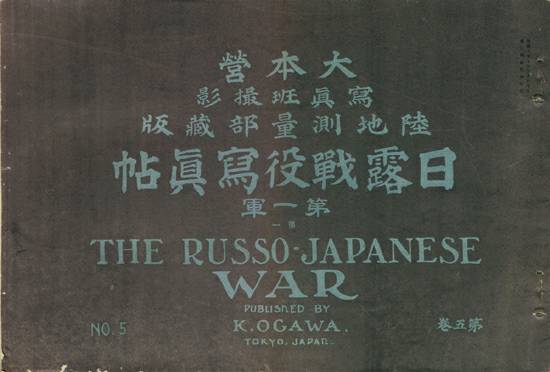
Title Page (English and Japanese)
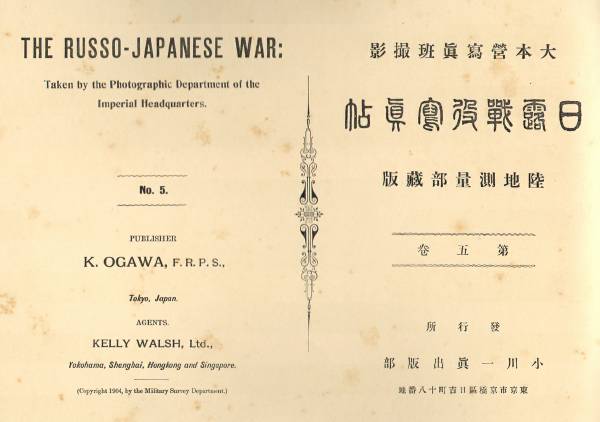 Contents Page (listing of plates)
Contents Page (listing of plates)
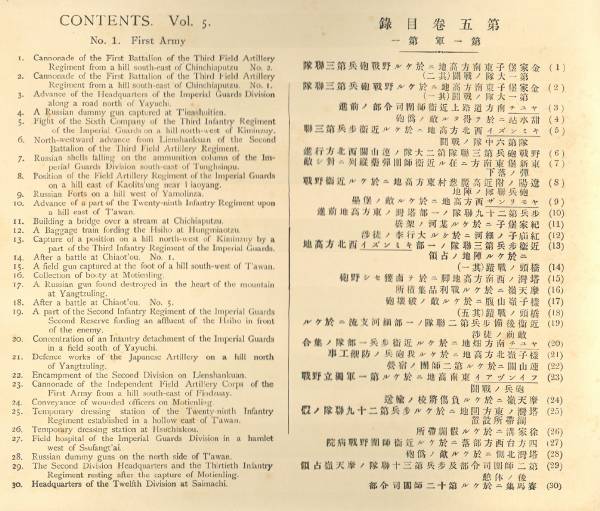 Portrait (General Baron Kuroki, Commander of the First Army)
Portrait (General Baron Kuroki, Commander of the First Army)
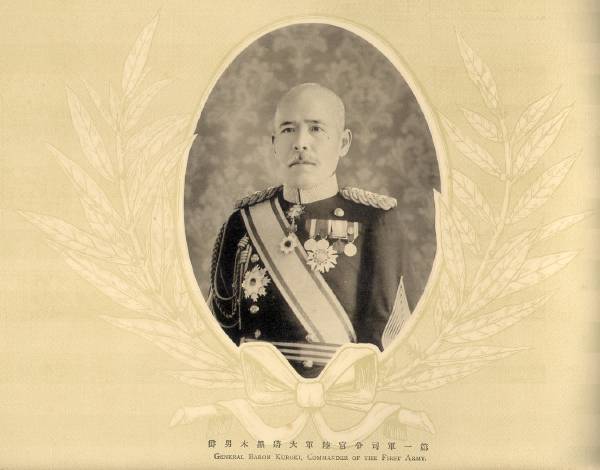 Portraits
(Lieutenant-General Inouye, Commander of the Twelfth Division
General Baron Hasegawa, Late Commander of the Imperial Guard Division
General Baron Nishi, Late Commander of the Second Division)
Portraits
(Lieutenant-General Inouye, Commander of the Twelfth Division
General Baron Hasegawa, Late Commander of the Imperial Guard Division
General Baron Nishi, Late Commander of the Second Division)
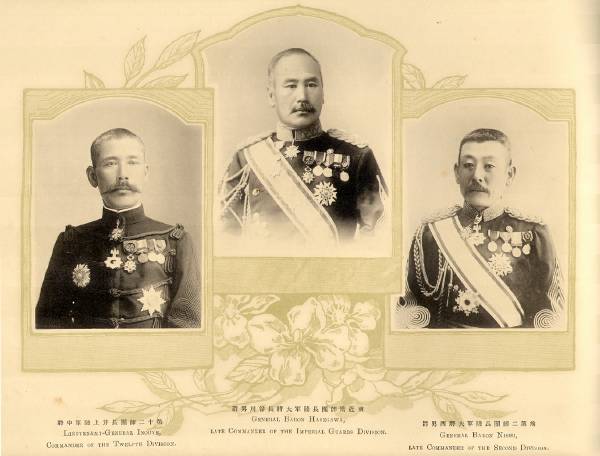 (1} Cannonade of the First Battalion of the Second Field
Artillery Regiment from a hill south-east of Chin-
chiaputzu. No. 2.
(1} Cannonade of the First Battalion of the Second Field
Artillery Regiment from a hill south-east of Chin-
chiaputzu. No. 2.
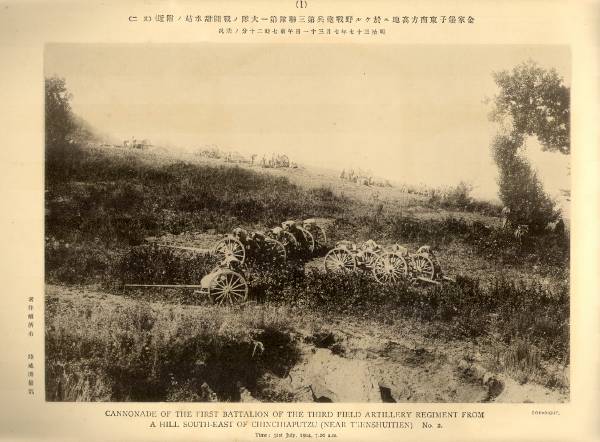 (2) Cannonade of the First Battalion of the Second Field
Artillery Regiment from a hill south-east of Chin-
chiaputzu. No. I.
(3) Advance of the Headquarters of the Imperial Guards
Division along a road north of Yayuchi.
(4) A Russian dummy gun captured at T'ienshuitien,
(5) Fight of the Sixth Company of the Third Infantry
Regiment of Imperial Guards on a hill north-west
of Kiminzuy.
(6) North-west ward advance from Lienshankuan of the Second
Battalion of the Third Field Artillery Regiment.
(7) Russian shells falling on the ammunition column of the
Imperial Guards Division south-east of Tunghsinpu.
(8) Position of the Field Artillery Regiment of the
Imperial Guards on a hill east of Kaolits'ung near Liaoyang.
(9) Russian Forts on a hill west of Yamolinza.
(10) Advance of a part of the Twenty-ninth Infantry Regiment
upon a hill east T'awan.
(2) Cannonade of the First Battalion of the Second Field
Artillery Regiment from a hill south-east of Chin-
chiaputzu. No. I.
(3) Advance of the Headquarters of the Imperial Guards
Division along a road north of Yayuchi.
(4) A Russian dummy gun captured at T'ienshuitien,
(5) Fight of the Sixth Company of the Third Infantry
Regiment of Imperial Guards on a hill north-west
of Kiminzuy.
(6) North-west ward advance from Lienshankuan of the Second
Battalion of the Third Field Artillery Regiment.
(7) Russian shells falling on the ammunition column of the
Imperial Guards Division south-east of Tunghsinpu.
(8) Position of the Field Artillery Regiment of the
Imperial Guards on a hill east of Kaolits'ung near Liaoyang.
(9) Russian Forts on a hill west of Yamolinza.
(10) Advance of a part of the Twenty-ninth Infantry Regiment
upon a hill east T'awan.
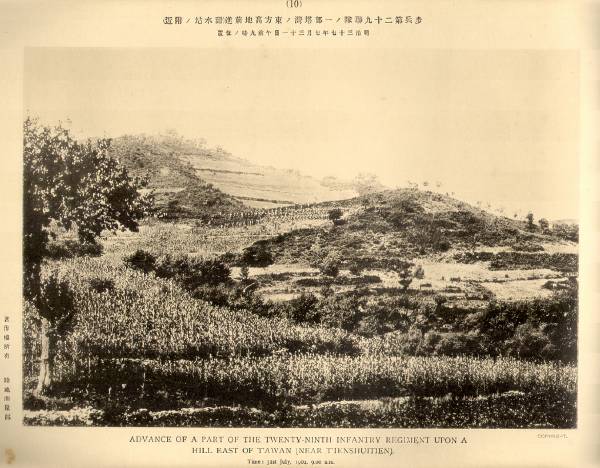 (11) Building a bridge over a stream at Chichiaputzu.
(12) A baggage train fording the Hsiho at Hungmiaotzu.
(13) Capture of a position on a hill north-west of Kiminzuy
by a part of the Third Infantry Regiment of the Imperial
Guards.
(14) After a battle at Chiaot'ou.
{15} A field gun captured at the foot of a hill south-west of
T'awan.
(11) Building a bridge over a stream at Chichiaputzu.
(12) A baggage train fording the Hsiho at Hungmiaotzu.
(13) Capture of a position on a hill north-west of Kiminzuy
by a part of the Third Infantry Regiment of the Imperial
Guards.
(14) After a battle at Chiaot'ou.
{15} A field gun captured at the foot of a hill south-west of
T'awan.
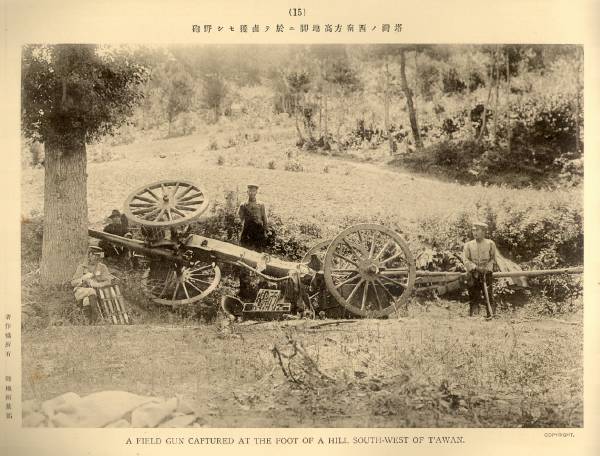 (16) Collection of booty at Motienling.
(17) A Russian gun found destroyed in the heart of the mountain
at Yangtzuling.
(18) After a battle at Chiaot'ou. No. 5.
(19) A part of the Second Infantry Regiment of the Imperial Guards
Second Reserve fording an affluent of the Hsiho in front of
the enemy.
(20) Concentration of an Infantry detachment of the Imperial Guards
in a field south of Yayuchi.
(21) Defence works of the Japanese Artillery on a hill north
of Yangtzuling.
(22) Encampment of the Second Division on Lienshankuan.
(16) Collection of booty at Motienling.
(17) A Russian gun found destroyed in the heart of the mountain
at Yangtzuling.
(18) After a battle at Chiaot'ou. No. 5.
(19) A part of the Second Infantry Regiment of the Imperial Guards
Second Reserve fording an affluent of the Hsiho in front of
the enemy.
(20) Concentration of an Infantry detachment of the Imperial Guards
in a field south of Yayuchi.
(21) Defence works of the Japanese Artillery on a hill north
of Yangtzuling.
(22) Encampment of the Second Division on Lienshankuan.
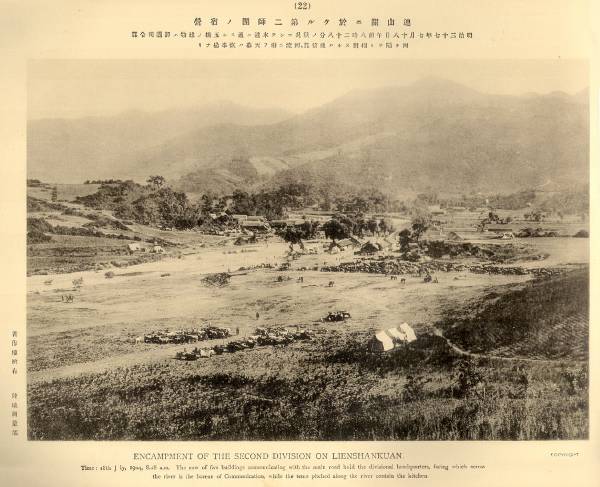 (23) Cannonade of the Independent Field Artillery Corps of the
First Army from a hill south-cast of Findzuay.
(24) Conveyance of wounded officers on Motienling.
(25) Temporary dressing station of the Twenty-ninth Infantry
Regiment established in a hollow east of T'awan.
(26) Temporary dressing station at Hsuchiakon.
(27) Field hospital of the Imperial Guards Division in
a hamlet west of Ssufangt'ai.
{28} Russian dummy guns on the north side of T'awan.
(29) The Second Division Headquarters and the Thirtieth Infantry
Regiment resting after the capture of Motienling.
(30) Headquarters of the Twelfth Division at Saimachi.
(23) Cannonade of the Independent Field Artillery Corps of the
First Army from a hill south-cast of Findzuay.
(24) Conveyance of wounded officers on Motienling.
(25) Temporary dressing station of the Twenty-ninth Infantry
Regiment established in a hollow east of T'awan.
(26) Temporary dressing station at Hsuchiakon.
(27) Field hospital of the Imperial Guards Division in
a hamlet west of Ssufangt'ai.
{28} Russian dummy guns on the north side of T'awan.
(29) The Second Division Headquarters and the Thirtieth Infantry
Regiment resting after the capture of Motienling.
(30) Headquarters of the Twelfth Division at Saimachi.
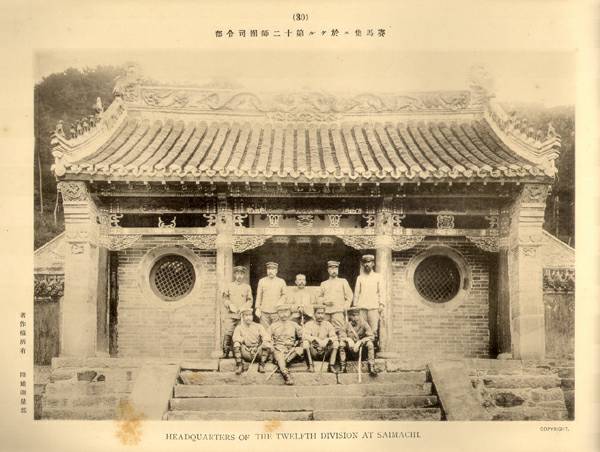 Colophon (Volume V)
Colophon (Volume V)
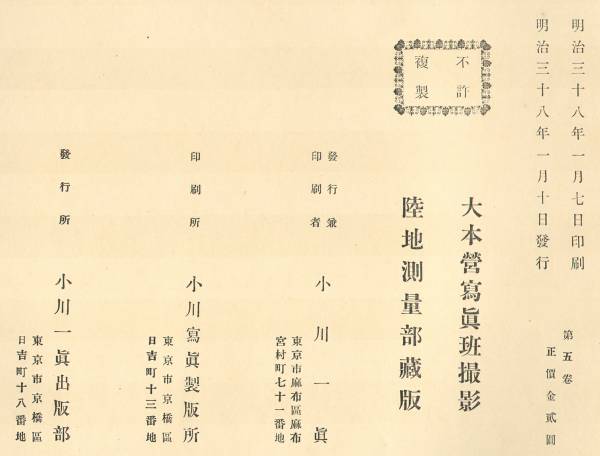 Printed Meiji 38 (1905).1.7
Published: Meiji 38 (1905).1.10
Printed Meiji 38 (1905).1.7
Published: Meiji 38 (1905).1.10
Volume VI, First Army, Part 2.
Covers
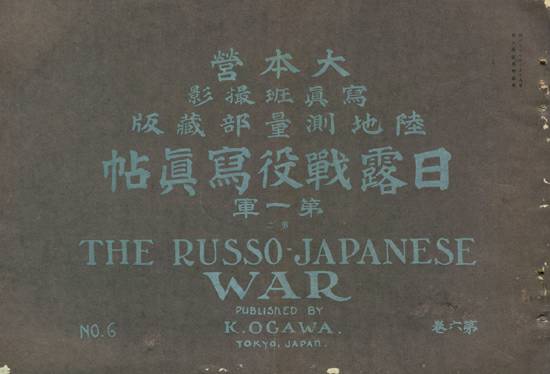
Title Page (English and Japanese)
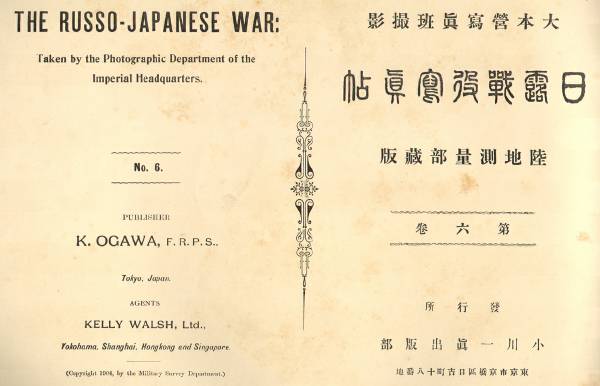 Contents Page (listing of plates)
Contents Page (listing of plates)
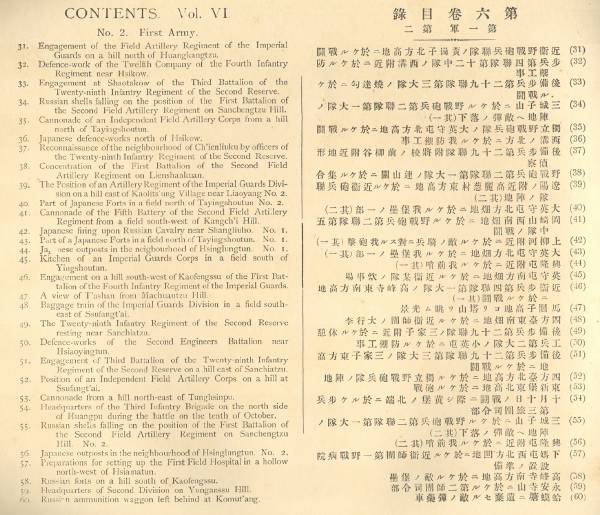 Portraits
Lieut. General Asada, Command of the Imperial Guard
Lieut. General Nishijima, Command of the Second Division
Portraits
Lieut. General Asada, Command of the Imperial Guard
Lieut. General Nishijima, Command of the Second Division
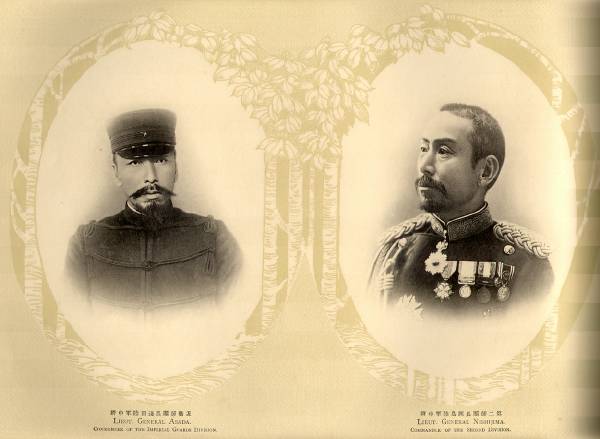 (31) Engagement of the Field Artillery Regiment of the Imperial
Guards on a hill north of Huangkangtzu.
(31) Engagement of the Field Artillery Regiment of the Imperial
Guards on a hill north of Huangkangtzu.
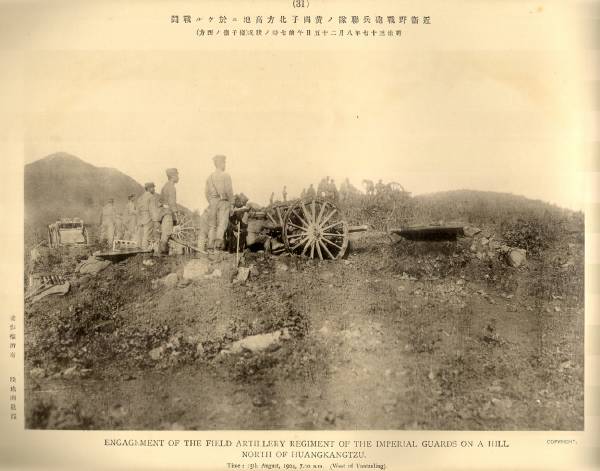 (32) Defence-work of the Twelfth Company of the Fourth Infantry
Regiment near Hsikow.
(33) Engagement at Shaotakow of the Third Battalion of the
Twenty-ninth Infantry Regiment of the Second Reserve.
(34) Russian shells falling on the position of the First Battalion
of the Second Field Artillery Regiment on Sanchengtm Hill.
(35) Cannonade of an Independent Field Artillery Corps from a hill
north of Tayingshoutun.
(36) Japanese defence-works north of Hsikow.
(37) Reconnaissance of the neighbourhood of Ch'icnliuku by officers
of the Twenty-ninth Infantry Regiment of the Second Reserve.
(38) Concentration of the First Battalion of the Second Field Artillery
Regiment on Lienshankuan.
(39) The Posilion of an Artillery Regiment of the Imperial Guards
Division on a hill cast of Kaolits'ung Village near
Liaoyang. No. 2.
(40) Part of Japanese Forts in a field north of
Tayingshoutun. No, 2.
(41) Cannonade of the Fifth Battery of the Second Field Artillery
Regiment from a field south-west of Kangch'i Hill.
(32) Defence-work of the Twelfth Company of the Fourth Infantry
Regiment near Hsikow.
(33) Engagement at Shaotakow of the Third Battalion of the
Twenty-ninth Infantry Regiment of the Second Reserve.
(34) Russian shells falling on the position of the First Battalion
of the Second Field Artillery Regiment on Sanchengtm Hill.
(35) Cannonade of an Independent Field Artillery Corps from a hill
north of Tayingshoutun.
(36) Japanese defence-works north of Hsikow.
(37) Reconnaissance of the neighbourhood of Ch'icnliuku by officers
of the Twenty-ninth Infantry Regiment of the Second Reserve.
(38) Concentration of the First Battalion of the Second Field Artillery
Regiment on Lienshankuan.
(39) The Posilion of an Artillery Regiment of the Imperial Guards
Division on a hill cast of Kaolits'ung Village near
Liaoyang. No. 2.
(40) Part of Japanese Forts in a field north of
Tayingshoutun. No, 2.
(41) Cannonade of the Fifth Battery of the Second Field Artillery
Regiment from a field south-west of Kangch'i Hill.
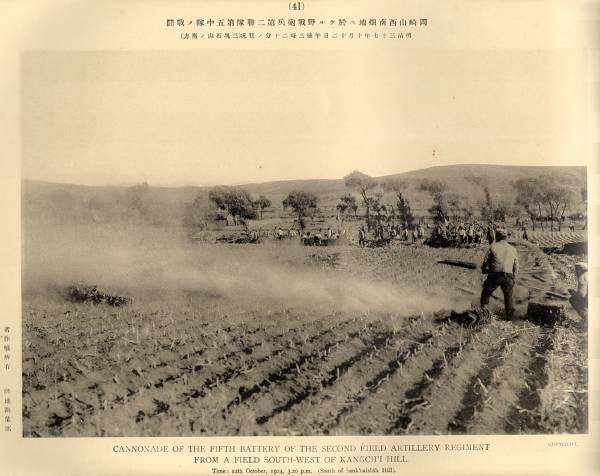 (42) Japanese firing upon Russian Cavalry near Shang-liuho. No. I.
(43) Part of Japanese Forts in a field north of
Tayingshoutun. No. I.
(44) Japanese outposts in the neighbourhood of
Hsing-hingtuti. No. I.
(45) Kitchen of an Imperial Guards Corps in a field south
of Yingshoutun.
(46) Engagement on a hill south-west of Kaofengssu of the First
Battalion of the Fourth Infantry Regiment of the Imperial
Guards. No. I.
(47) A view of T'ashan from Machuantzu Hill.
(48) Baggage (rain of the Imperial Guards Division in a field
south-east of Ssufangt'ai.
(49) The Twenty-ninth Infantry Regiment of the Second Reserve
resting near Sanchiatzu.
(50) Defence-works of the Second Engineers Battalion near
Hsiaoyingtim.
(51) Engagement of Third Battalion of the Twenty-ninth Infantry
Regiment of the Second Reserve on a hill east of Sanchiatzu.
(52) Position of an Independent Field Artillery Corps on a hill at
Ssufangt'ai.
(53) Cannonade from a hill north-east of Tunghsinpu.
(54) Headquarters of the Third Infantry Brigade on the north side of
Huangpu during the battle on the tenth of October.
(55) Russian shells falling on the position of the First Battalion of
the Second Field Artillery Regiment on Sanchengtm Hill. No. 2.
(56) Japanese outposts in the neighbourhood of Ilsing-lungtun. No. 2.
(57) Preparations for setting up the First Field Hospital of the
Imperial Guards Division in a hollow northwest of llsiamatun.
(58) Russian forts on a hill south of Kaofengssu.
(59) Headquarters of the Second Division on Yuuganssii Hill.
(60) Russian ammunition wagon left behind at Komut'ang.
(42) Japanese firing upon Russian Cavalry near Shang-liuho. No. I.
(43) Part of Japanese Forts in a field north of
Tayingshoutun. No. I.
(44) Japanese outposts in the neighbourhood of
Hsing-hingtuti. No. I.
(45) Kitchen of an Imperial Guards Corps in a field south
of Yingshoutun.
(46) Engagement on a hill south-west of Kaofengssu of the First
Battalion of the Fourth Infantry Regiment of the Imperial
Guards. No. I.
(47) A view of T'ashan from Machuantzu Hill.
(48) Baggage (rain of the Imperial Guards Division in a field
south-east of Ssufangt'ai.
(49) The Twenty-ninth Infantry Regiment of the Second Reserve
resting near Sanchiatzu.
(50) Defence-works of the Second Engineers Battalion near
Hsiaoyingtim.
(51) Engagement of Third Battalion of the Twenty-ninth Infantry
Regiment of the Second Reserve on a hill east of Sanchiatzu.
(52) Position of an Independent Field Artillery Corps on a hill at
Ssufangt'ai.
(53) Cannonade from a hill north-east of Tunghsinpu.
(54) Headquarters of the Third Infantry Brigade on the north side of
Huangpu during the battle on the tenth of October.
(55) Russian shells falling on the position of the First Battalion of
the Second Field Artillery Regiment on Sanchengtm Hill. No. 2.
(56) Japanese outposts in the neighbourhood of Ilsing-lungtun. No. 2.
(57) Preparations for setting up the First Field Hospital of the
Imperial Guards Division in a hollow northwest of llsiamatun.
(58) Russian forts on a hill south of Kaofengssu.
(59) Headquarters of the Second Division on Yuuganssii Hill.
(60) Russian ammunition wagon left behind at Komut'ang.
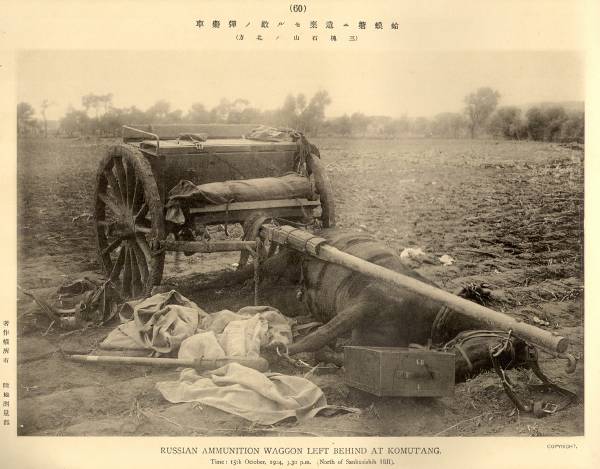 Colophon (Volume VI)
Colophon (Volume VI)
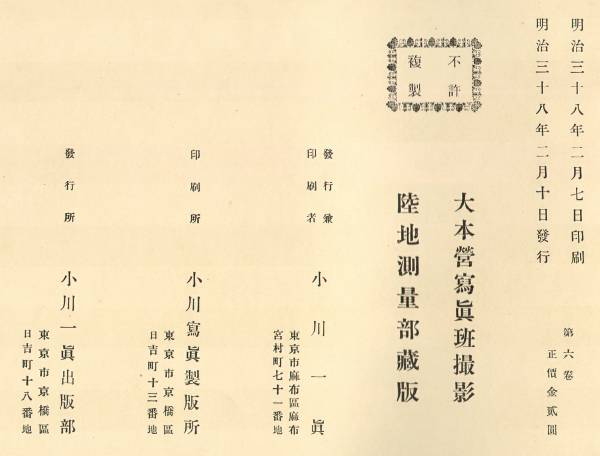 Printed Meiji 38 (1905).2.7
Published: Meiji 38 (1905).2.10
Printed Meiji 38 (1905).2.7
Published: Meiji 38 (1905).2.10
Volume XVIII, First Army Part 3.
Covers
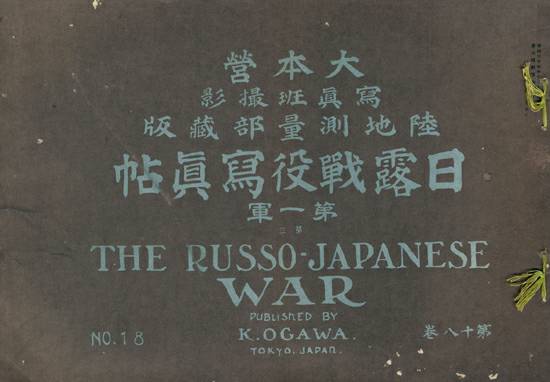
Title Page (English and Japanese)
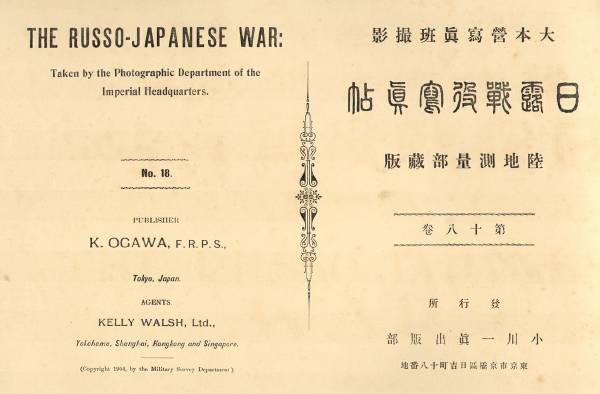 Contents Page (listing of plates)
Contents Page (listing of plates)
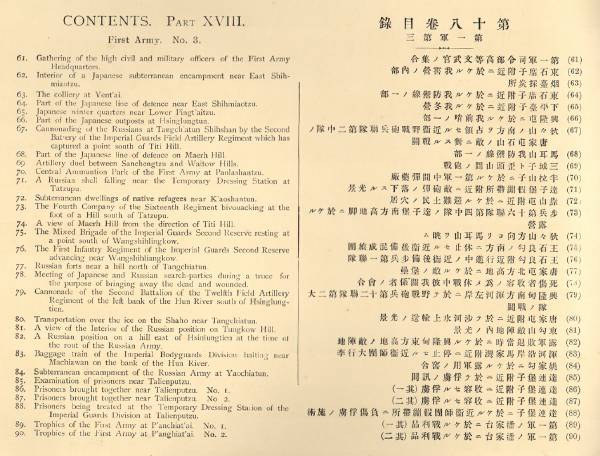 (61) Gathering of the high civil and military officers of the First
Army Headquarters.
(61) Gathering of the high civil and military officers of the First
Army Headquarters.
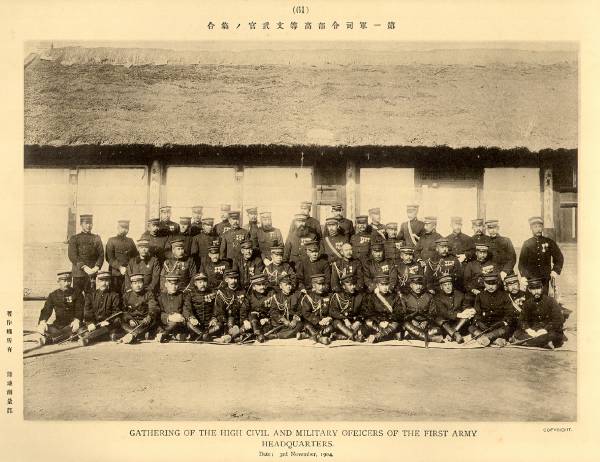 (62) Interior of a Japanese subterranean encampment near East
Shihmiaotzu.
(62) Interior of a Japanese subterranean encampment near East
Shihmiaotzu.
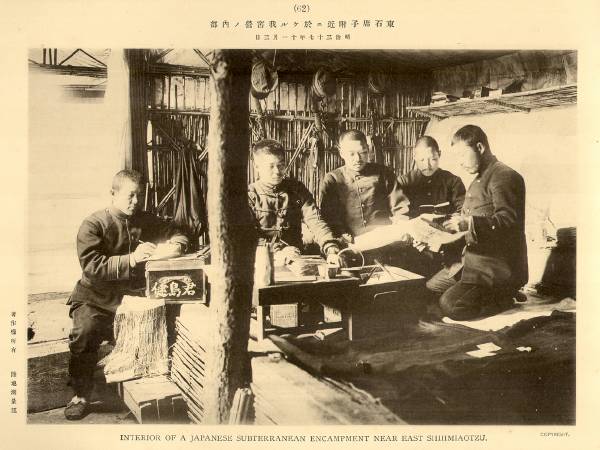 (63) The colliery at Yent'ai.
(64) Part of the Japanese line of defence near East Shih-miaotzu.
(65) Japanese winter quarters near Lower Pingt'aitzu,
(66) Part of the Japanese outposts at Hsinglungtun.
(67) Cannonading of the Russians at Tangchiatun Shihshan by the
Second Battery of the Imperial Guards Field Artillery Regiment
which has captured a point south of Titi Hill.
(681 Part of the Japanese line of defence on Maerh Hill.
(69) Artillery duel between Sanchengtzu and Waitow Hills.
(70) Central Ammunition Park of the First Army at Pan-lash an tan.
(63) The colliery at Yent'ai.
(64) Part of the Japanese line of defence near East Shih-miaotzu.
(65) Japanese winter quarters near Lower Pingt'aitzu,
(66) Part of the Japanese outposts at Hsinglungtun.
(67) Cannonading of the Russians at Tangchiatun Shihshan by the
Second Battery of the Imperial Guards Field Artillery Regiment
which has captured a point south of Titi Hill.
(681 Part of the Japanese line of defence on Maerh Hill.
(69) Artillery duel between Sanchengtzu and Waitow Hills.
(70) Central Ammunition Park of the First Army at Pan-lash an tan.
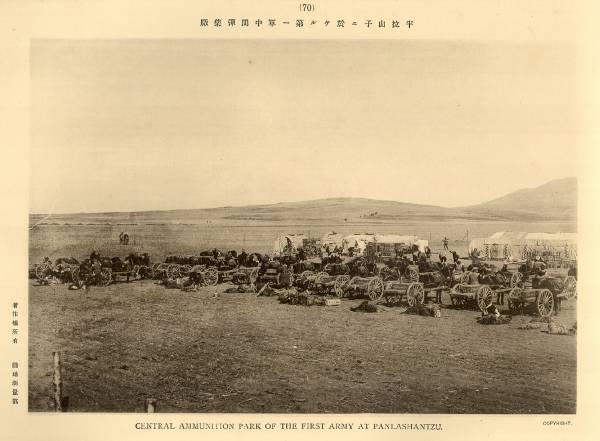 (7l) A Russian shell falling near the Temporary Dressing Station
at Tatzupu.
(72) Subterranean dwellings of native refugees near K'ao-shantun.
(73) The Fourth Company of the Sixteenth Regiment bivouacking at the
foot of a hill south of Tataupu.
(74) A view of Maerh Hill from the direction of Titi Hill.
(75) The Mixed Brigade of the Imperial Guards Second
Reserve resting at a point south of Wangshihling-kow.
(76) The First Infantry Regiment of the Imperial Guards Second
Reserve advancing near Wangshihliangkow.
(77) Russian forts near a hill north of Tangchiatun.
(78) Meeting of Japanese and Russian search-parties during a truce for
the purpose of bringing away the dead and wounded.
(7l) A Russian shell falling near the Temporary Dressing Station
at Tatzupu.
(72) Subterranean dwellings of native refugees near K'ao-shantun.
(73) The Fourth Company of the Sixteenth Regiment bivouacking at the
foot of a hill south of Tataupu.
(74) A view of Maerh Hill from the direction of Titi Hill.
(75) The Mixed Brigade of the Imperial Guards Second
Reserve resting at a point south of Wangshihling-kow.
(76) The First Infantry Regiment of the Imperial Guards Second
Reserve advancing near Wangshihliangkow.
(77) Russian forts near a hill north of Tangchiatun.
(78) Meeting of Japanese and Russian search-parties during a truce for
the purpose of bringing away the dead and wounded.
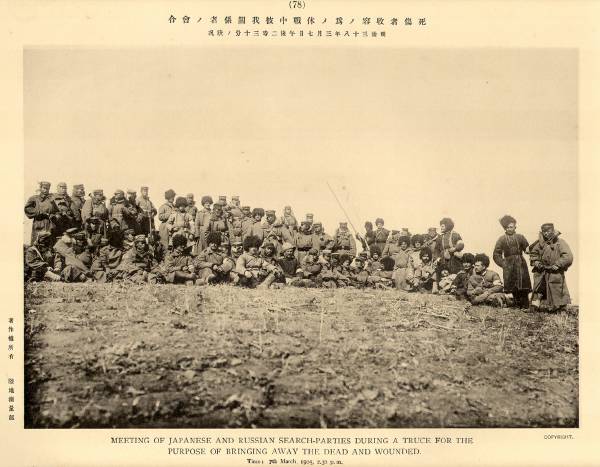 (79) Cannonade of the Second Battalion of the Twelfth Field Artillery
Regiment on the left bank of the Hun River south of Hsinglungtien.
(80) Transportation over the ice on the Shaho near Tangchiatun.
(81) A view of the Interior of the Russian position on
Tungkow Hill.
(82) A Russian position on a hill east of Hsinlungtien at the time of
the rout of the Russian Army.
(83) Baggage train of the Imperial Bodyguards Division halting near
Machiawan on the bank of the Hun River.
(84) Subterranean encampment of the Russian Army at Yaochiatun.
(85) Examination of prisoners near Talienputzu.
(79) Cannonade of the Second Battalion of the Twelfth Field Artillery
Regiment on the left bank of the Hun River south of Hsinglungtien.
(80) Transportation over the ice on the Shaho near Tangchiatun.
(81) A view of the Interior of the Russian position on
Tungkow Hill.
(82) A Russian position on a hill east of Hsinlungtien at the time of
the rout of the Russian Army.
(83) Baggage train of the Imperial Bodyguards Division halting near
Machiawan on the bank of the Hun River.
(84) Subterranean encampment of the Russian Army at Yaochiatun.
(85) Examination of prisoners near Talienputzu.
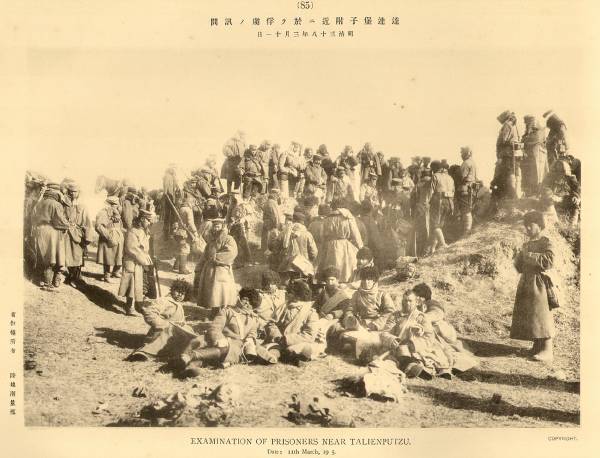 (86) Prisoners brought together near Talieuputzu. No. 1.
(87) Prisoners brought together near Talienpulzu. No. 2.
(88) Prisoners being treated at the Temporary Dressing Station of
the Imperial Guards Division at Talienputzu.
(89) Trophies of the First Army at P'anchiat'ai. No. 1.
(90) Trophies of the First Army at P'anchiat'ai. No. 2.
(86) Prisoners brought together near Talieuputzu. No. 1.
(87) Prisoners brought together near Talienpulzu. No. 2.
(88) Prisoners being treated at the Temporary Dressing Station of
the Imperial Guards Division at Talienputzu.
(89) Trophies of the First Army at P'anchiat'ai. No. 1.
(90) Trophies of the First Army at P'anchiat'ai. No. 2.
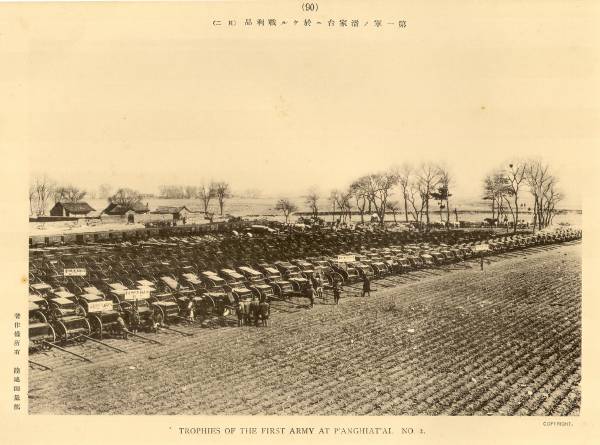 Colophon (Volume XVIII)
Colophon (Volume XVIII)
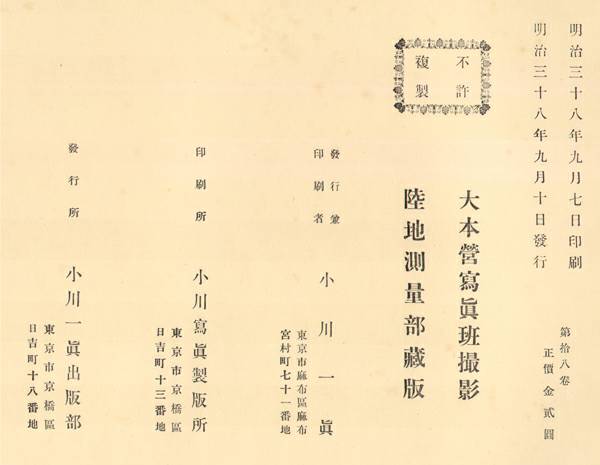 Printed Meiji 38 (1905).9.7
Published: Meiji 38 (1905).9.10
Printed Meiji 38 (1905).9.7
Published: Meiji 38 (1905).9.10
Volumes VII-XIV - Third Army, Parts No. 1-8
(224 Numbered Plates:)
Volume VII, Third Army, Part 1.
Covers
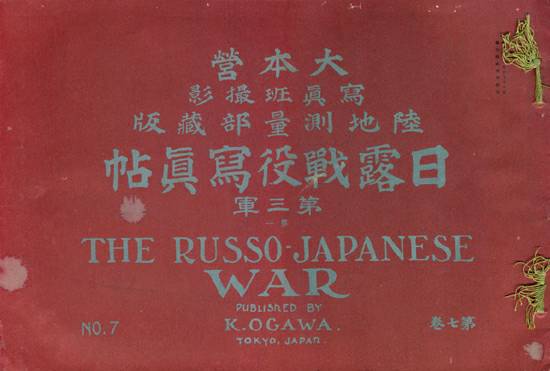
Title Page (English and Japanese)
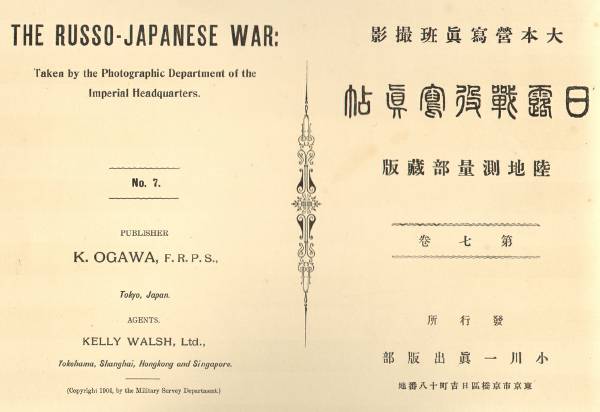 Contents Page (listing of plates)
Contents Page (listing of plates)
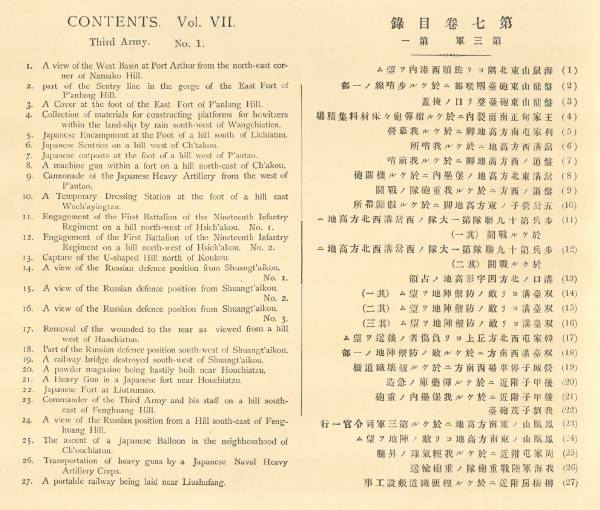 Portraits
General Baron Nogi, Commander Third Army
Major General Ijichi, Chief of the Third Army Staff
Portraits
General Baron Nogi, Commander Third Army
Major General Ijichi, Chief of the Third Army Staff
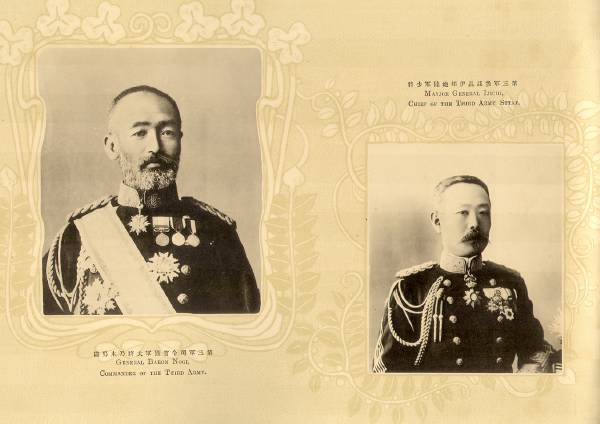 (1) A view of the West Basin at Port Arthur from the
north-east corner of Namako Hill.
(fold-out plate - 60 x 26.5 cm)
(1) A view of the West Basin at Port Arthur from the
north-east corner of Namako Hill.
(fold-out plate - 60 x 26.5 cm)
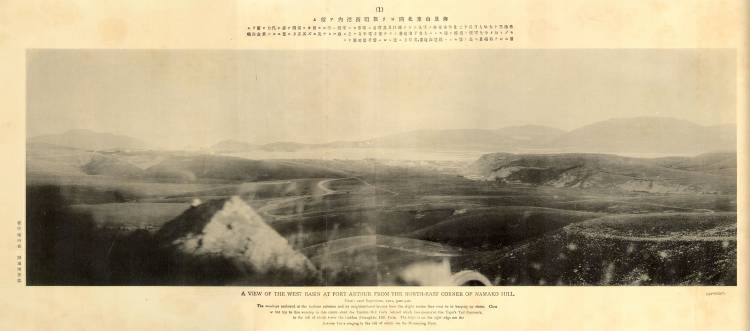 (2) Part of the sentry line in the gorge of the East
Fort of P'anlung Hill.
(3) A cover at the foot of the East Fort of P'anlung
Hill.
(4) Collection of materials for constructing platforms
for howitzers within the land-slip by rain
south-west of Wangchiatien.
(5) Japanese encampment at the foot of a hill south
of Lichiatun.
(6) Japanese sentries on a hill west of Cli'iakou.
(7) Japanese outposts at the foot of a hill west
of P'antao.
(8} A machine gun within a fort on a hill north-east
of Ch'akou.
(2) Part of the sentry line in the gorge of the East
Fort of P'anlung Hill.
(3) A cover at the foot of the East Fort of P'anlung
Hill.
(4) Collection of materials for constructing platforms
for howitzers within the land-slip by rain
south-west of Wangchiatien.
(5) Japanese encampment at the foot of a hill south
of Lichiatun.
(6) Japanese sentries on a hill west of Cli'iakou.
(7) Japanese outposts at the foot of a hill west
of P'antao.
(8} A machine gun within a fort on a hill north-east
of Ch'akou.
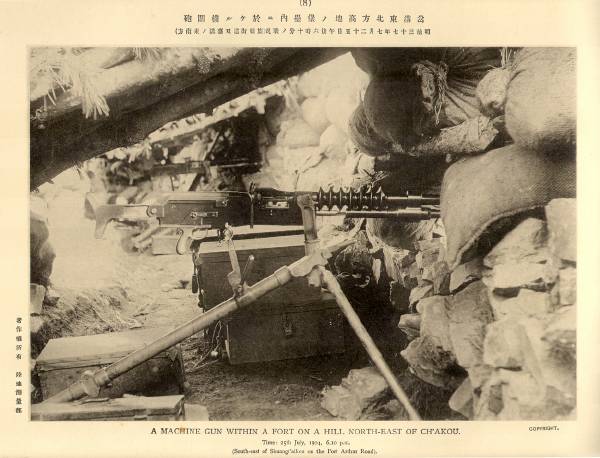 (9} Cannonade of the Japanese Heavy Artillery from
the west of P'antao.
(10) A temporary dressing at the foot of a hill east of Wuch'ayingtzu.
(11) Engagement of the First Battalion of the Nineteenth
Infantry Regiment on a hill north-west of
Hsich'akou. No. 1.
(12) Engagement of the First Battalion of the
Nineteenth Infantry Regiment on a hill
north-west of Hsich'akou. No. 2.
(13) Capture of the U-shaped Hill north of Koukou.
(14) A view of the Russian defence position from
Shuangt'aikou. No. 1.
(15) A view of the Russian defence position from
Shuangt'aikou. No. 2.
(9} Cannonade of the Japanese Heavy Artillery from
the west of P'antao.
(10) A temporary dressing at the foot of a hill east of Wuch'ayingtzu.
(11) Engagement of the First Battalion of the Nineteenth
Infantry Regiment on a hill north-west of
Hsich'akou. No. 1.
(12) Engagement of the First Battalion of the
Nineteenth Infantry Regiment on a hill
north-west of Hsich'akou. No. 2.
(13) Capture of the U-shaped Hill north of Koukou.
(14) A view of the Russian defence position from
Shuangt'aikou. No. 1.
(15) A view of the Russian defence position from
Shuangt'aikou. No. 2.
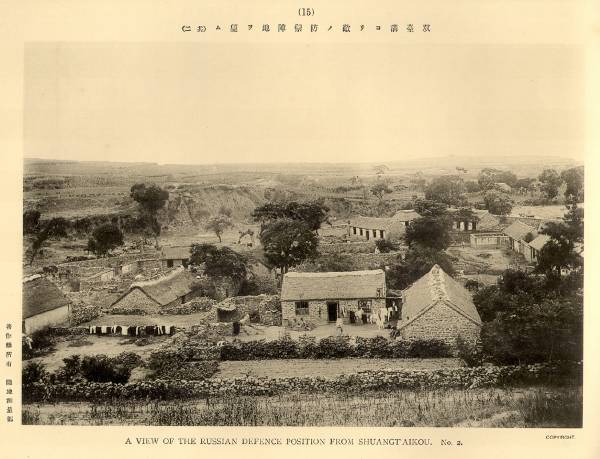 (16) A view of the Russian defence position from
Shuangt'aikou. No. 3.
(17) Removal of the wounded to the rear as viewed
from a hill north-west of Hanchiatun.
(18) Part of the Russian defence position south-west
of Shuangt'aikou.
(19) A railway bridge destroyed south-west of
Shuangt'aikou station.
(20) A powder magazine being hastily built near
Houchiattzu.
(21) A heavy gun in a Japanese fort near Houchiatzu.
(22) Japanese Fort at Lintziimao.
(23) Commander of the Third Army and his staff on a
hill southeast of Fenghuang Hill.
(16) A view of the Russian defence position from
Shuangt'aikou. No. 3.
(17) Removal of the wounded to the rear as viewed
from a hill north-west of Hanchiatun.
(18) Part of the Russian defence position south-west
of Shuangt'aikou.
(19) A railway bridge destroyed south-west of
Shuangt'aikou station.
(20) A powder magazine being hastily built near
Houchiattzu.
(21) A heavy gun in a Japanese fort near Houchiatzu.
(22) Japanese Fort at Lintziimao.
(23) Commander of the Third Army and his staff on a
hill southeast of Fenghuang Hill.
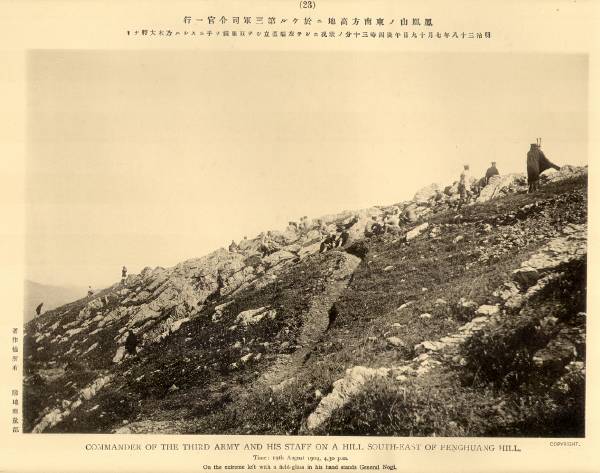 (24) A view of the Russian position from a hill
south-east of Fenghuang Hill.
(25) The ascent of a Japanese balloon in the
neighbourbood of Ch'oLichiatnn.
(26) Transportation of heavy guns by a Japanese
Naval Heavy Artillery Corps.
(27) A portable railway being laid near Liushufang.
(24) A view of the Russian position from a hill
south-east of Fenghuang Hill.
(25) The ascent of a Japanese balloon in the
neighbourbood of Ch'oLichiatnn.
(26) Transportation of heavy guns by a Japanese
Naval Heavy Artillery Corps.
(27) A portable railway being laid near Liushufang.
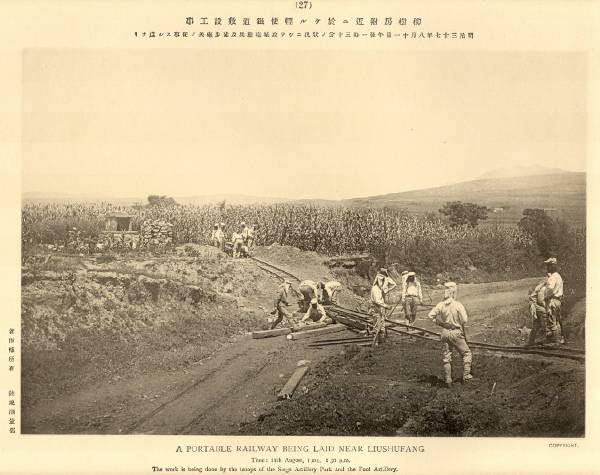 Colophon (Volume VII)
Colophon (Volume VII)
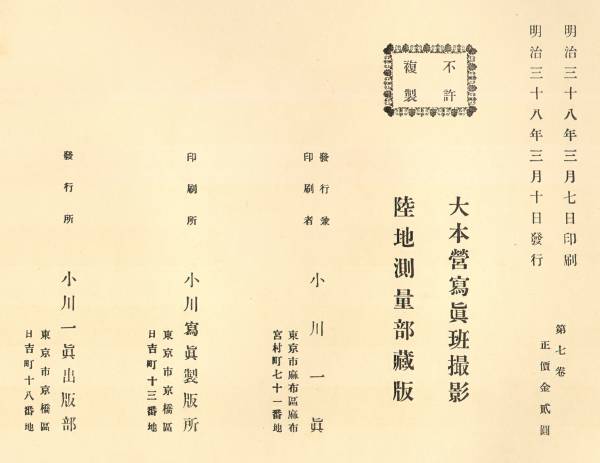 Printed Meiji 38 (1905).3.7
Published: Meiji 38 (1905).3.10
Printed Meiji 38 (1905).3.7
Published: Meiji 38 (1905).3.10
Volume VIII, Third Army, Part 2.
Covers
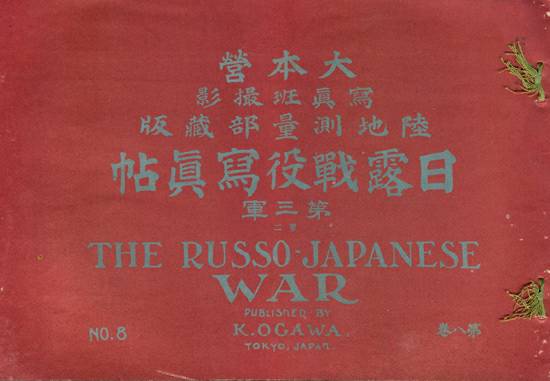
Title Page (English and Japanese)
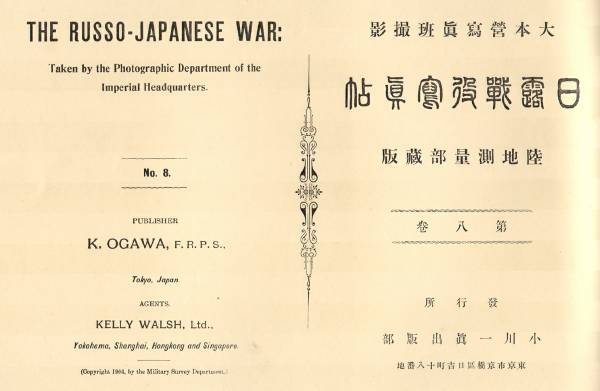 Contents Page (listing of plates)
Contents Page (listing of plates)
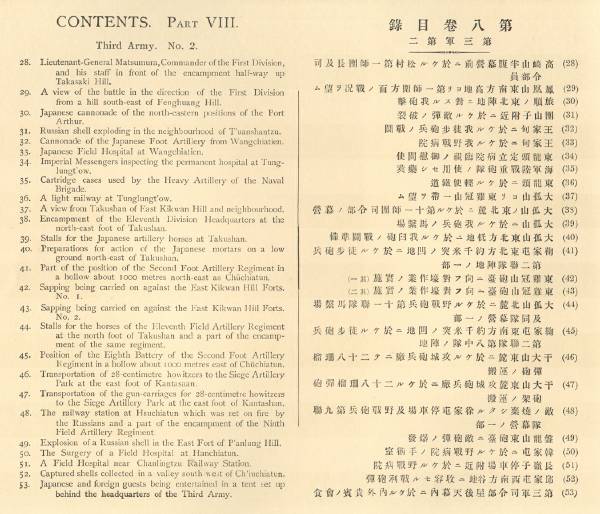 (28) Lieutenant-General Matsumura, Commander of the
First Division, and his staff in the front of
the encampment half-way up Takasaki Hill.
(28) Lieutenant-General Matsumura, Commander of the
First Division, and his staff in the front of
the encampment half-way up Takasaki Hill.
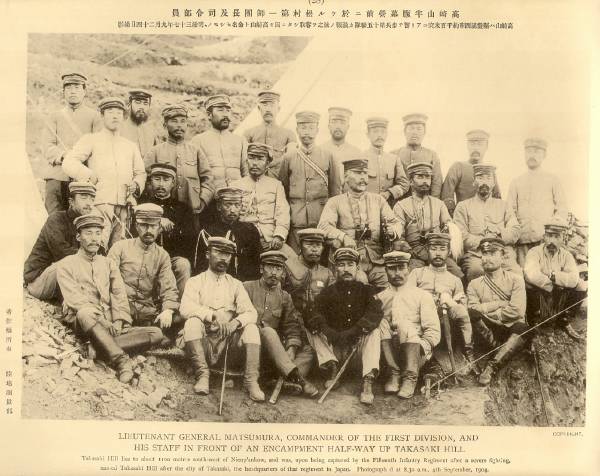 (29) A view of the battle in the direction of the First
Division from a hill south-east of Fenghuang Hill.
(fold-out plate - 54 x 26.5 cm)
(29) A view of the battle in the direction of the First
Division from a hill south-east of Fenghuang Hill.
(fold-out plate - 54 x 26.5 cm)
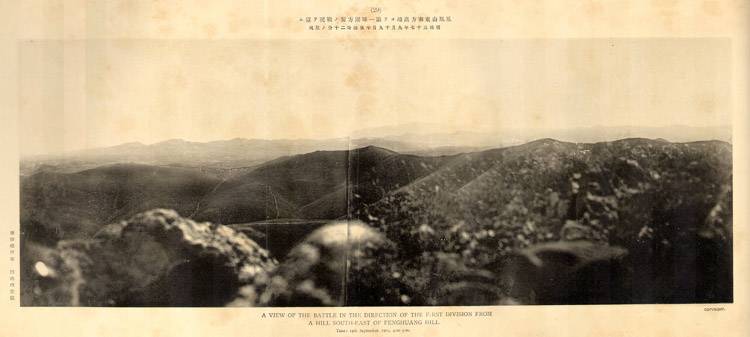 (30) Japanese cannonade of the north-eastern position
of the Port Arthur.
(31} Russian shell exploding in the neighbourhood of
Tuanshantzu.
(32) Cannonade of the Japanese Foot Artillery from
Wangchiatien.
(33) Japanese Field Hospital at Wangchiatien.
(34) Imperial Messengers inspecting the permanent
hospital at Tung-lungt'ow.
(30) Japanese cannonade of the north-eastern position
of the Port Arthur.
(31} Russian shell exploding in the neighbourhood of
Tuanshantzu.
(32) Cannonade of the Japanese Foot Artillery from
Wangchiatien.
(33) Japanese Field Hospital at Wangchiatien.
(34) Imperial Messengers inspecting the permanent
hospital at Tung-lungt'ow.
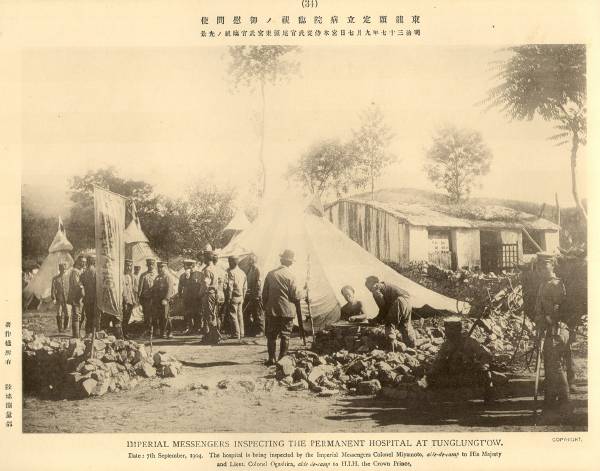 (35} Cartridge cases used by the Heavy Artillery of
the Naval Brigade.
(36) A light railway at Tunglungt'ow.
(37) A view from Takushan of East Kikwan Hill and neighbourhood.
(tissue overlay showing terrain features)
(35} Cartridge cases used by the Heavy Artillery of
the Naval Brigade.
(36) A light railway at Tunglungt'ow.
(37) A view from Takushan of East Kikwan Hill and neighbourhood.
(tissue overlay showing terrain features)
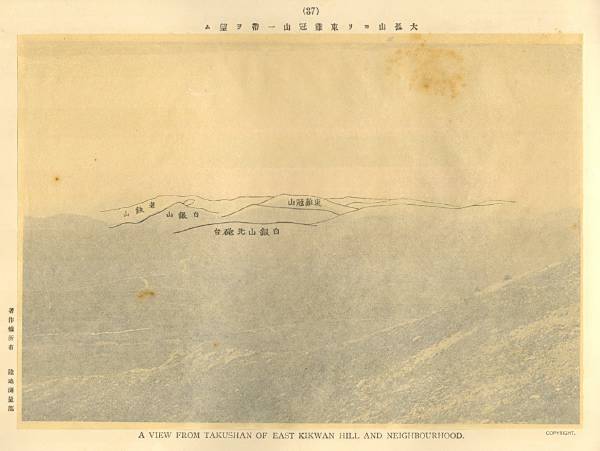 (38) Encampment of the Eleventh Division Headquarters
at the north-east foot of Takushan.
(39) Stalls for the Japanese artillery horses at Takushan.
(40) Preparations for action of the Japanese mortars
on a low ground north-east of Takushnn,
(41) Part of the position of the Second Foot Artillery
Regiment in a hollow about 1,000 metres
north-east of Chiichiatun.
(42) Sapping being carried on against the East Kikwan
Hill Forts. No. 1.
(43) Sapping being carried on against the East Kikwan
Hill Forts. No. 2.
(44) Stalls for the horses of the Eleventh Field
Artillery Regiment at the north foot of Takushan
and a part of the encampment of the same regiment
(45) Position of the Eighth Battery of the Second
Artillery Regiment in a hollow about 1,000 metres
east of Chuchiatun.
(46) Transportation of 28-centimetre howitzers to the
Siege Artillery Park at the east foot of
Kantashan.
(47) Transportation of the gun-carriages for
28-centimetre howitzers to the Siege Artillery
Park at the east foot of Kantashan.
(48) The railway station at Hsuchiatun which was set
on fire by the Russians and a part of the
encampment of the Ninth Field Artillery Regiment.
(38) Encampment of the Eleventh Division Headquarters
at the north-east foot of Takushan.
(39) Stalls for the Japanese artillery horses at Takushan.
(40) Preparations for action of the Japanese mortars
on a low ground north-east of Takushnn,
(41) Part of the position of the Second Foot Artillery
Regiment in a hollow about 1,000 metres
north-east of Chiichiatun.
(42) Sapping being carried on against the East Kikwan
Hill Forts. No. 1.
(43) Sapping being carried on against the East Kikwan
Hill Forts. No. 2.
(44) Stalls for the horses of the Eleventh Field
Artillery Regiment at the north foot of Takushan
and a part of the encampment of the same regiment
(45) Position of the Eighth Battery of the Second
Artillery Regiment in a hollow about 1,000 metres
east of Chuchiatun.
(46) Transportation of 28-centimetre howitzers to the
Siege Artillery Park at the east foot of
Kantashan.
(47) Transportation of the gun-carriages for
28-centimetre howitzers to the Siege Artillery
Park at the east foot of Kantashan.
(48) The railway station at Hsuchiatun which was set
on fire by the Russians and a part of the
encampment of the Ninth Field Artillery Regiment.
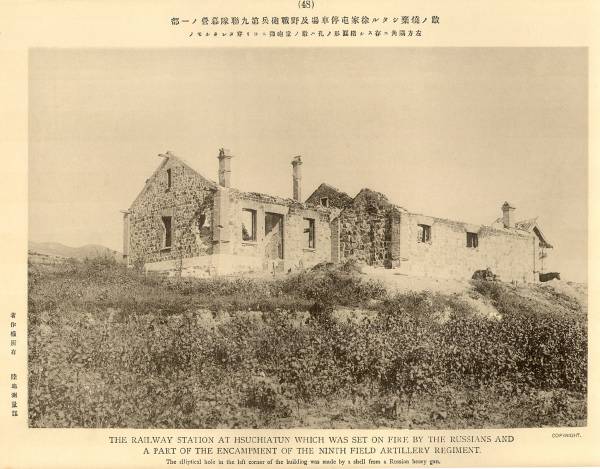 (49) Explosion of a Russian shell in the East Fort of Panlung Hill.
(tissue overlay showing terrain features)
(49) Explosion of a Russian shell in the East Fort of Panlung Hill.
(tissue overlay showing terrain features)
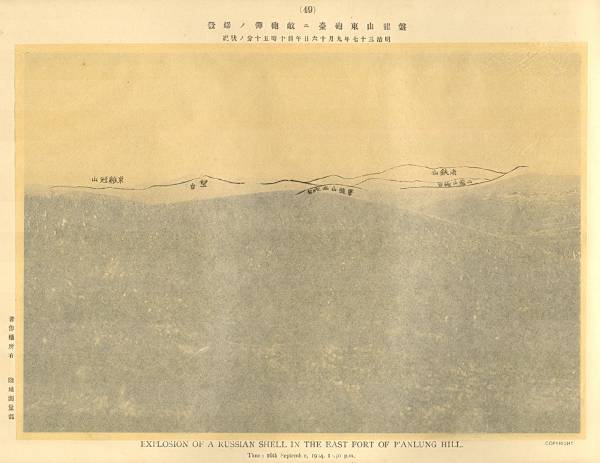 (50) The Surgery of a Field Hospital at Hanchiatun.
(51) A Field Hospital near Chanlingtzu Railway Station.
(52) Captured shells collected in a valley south-west
of Ch'iuchiatun.
(53) Japanese and foreign guest being entertained in
a tent set up behind the Headquarters of the Third Army,
(50) The Surgery of a Field Hospital at Hanchiatun.
(51) A Field Hospital near Chanlingtzu Railway Station.
(52) Captured shells collected in a valley south-west
of Ch'iuchiatun.
(53) Japanese and foreign guest being entertained in
a tent set up behind the Headquarters of the Third Army,
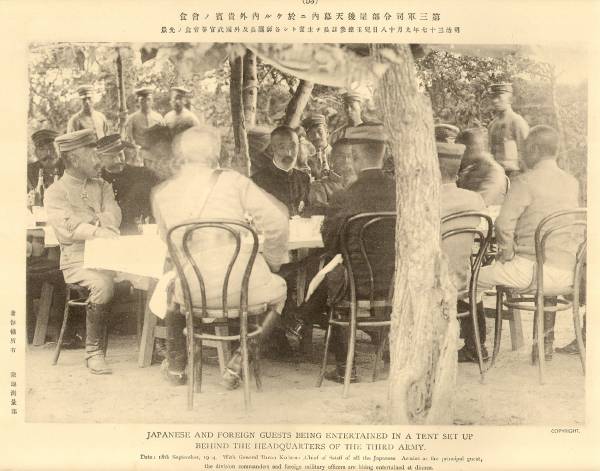 Colophon (Volume VIII)
Colophon (Volume VIII)
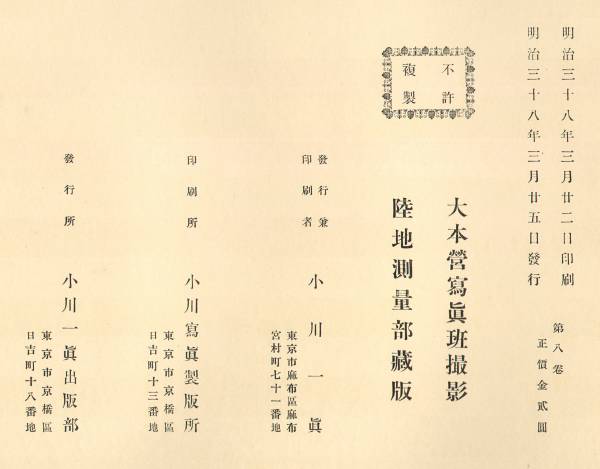 Printed Meiji 38 (1905).3.22
Published: Meiji 38 (1905).3.25
Printed Meiji 38 (1905).3.22
Published: Meiji 38 (1905).3.25
Volume IX, Third Army, Part 3.
Covers
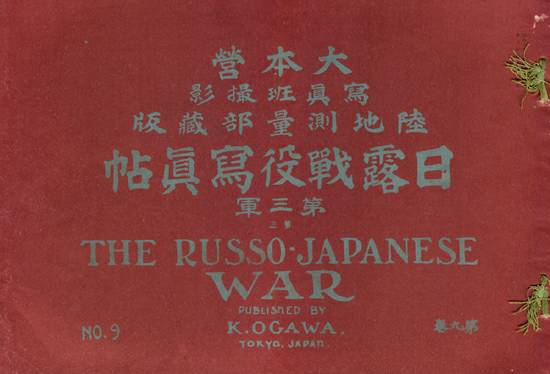
Title Page (English and Japanese)
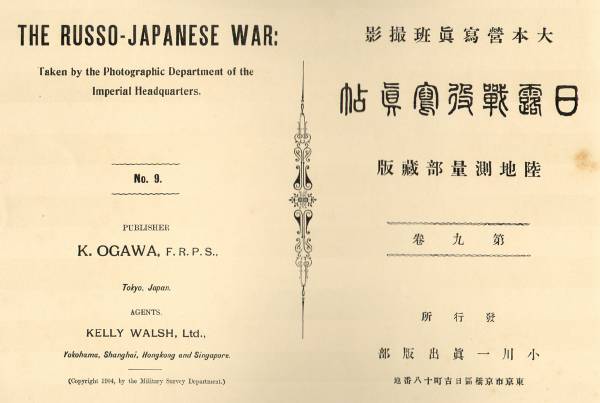 Contents Page (listing of plates)
Contents Page (listing of plates)
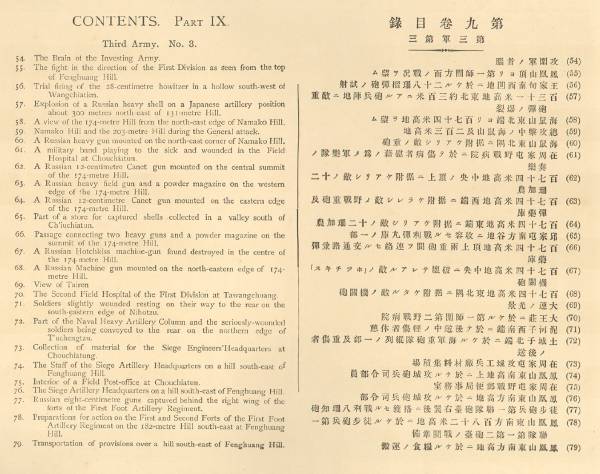 (54} The Brain of the Investing Army.
(54} The Brain of the Investing Army.
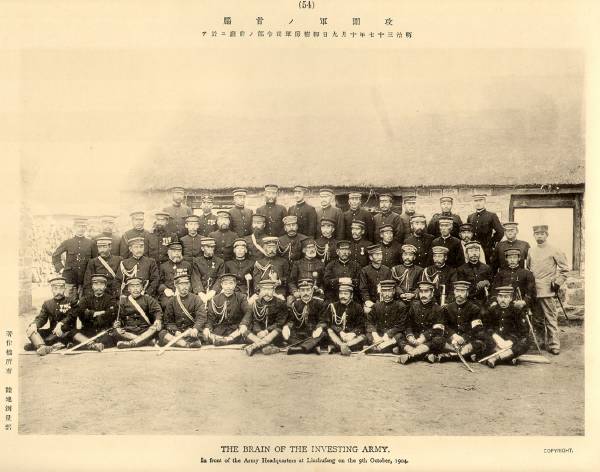 (55) The fight in the direction of the First
Division as seen from the top of Fenghuang Hill.
(fold-out plate - 54 x 26.5 cm with tissue overlay)
(55) The fight in the direction of the First
Division as seen from the top of Fenghuang Hill.
(fold-out plate - 54 x 26.5 cm with tissue overlay)
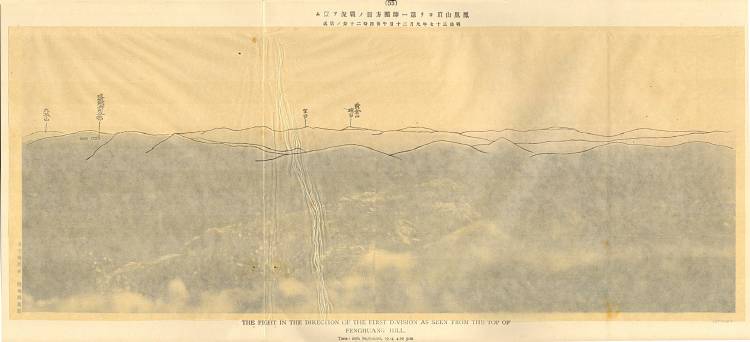 (56) Trial firing of the 28-centimetre howitzer in a
hollow south-west of Wangchiatien.
(57) Explosion of a Russian heavy shell on a Japanese
artillery position about 300 metres north-east
of 131-metre Hill.
(58) A view of the 174-metre Hill from the north-east
edge of Namako Hill.
(59) Namako Hill and the 2O3-metre Hill during the
General Attack.
(60) A Russian heavy gun mounted on the north-east
corner of Namako Hill.
(61) A military band playing to the sick and wounded
in the Field Hospital at Chouchiatun.
(56) Trial firing of the 28-centimetre howitzer in a
hollow south-west of Wangchiatien.
(57) Explosion of a Russian heavy shell on a Japanese
artillery position about 300 metres north-east
of 131-metre Hill.
(58) A view of the 174-metre Hill from the north-east
edge of Namako Hill.
(59) Namako Hill and the 2O3-metre Hill during the
General Attack.
(60) A Russian heavy gun mounted on the north-east
corner of Namako Hill.
(61) A military band playing to the sick and wounded
in the Field Hospital at Chouchiatun.
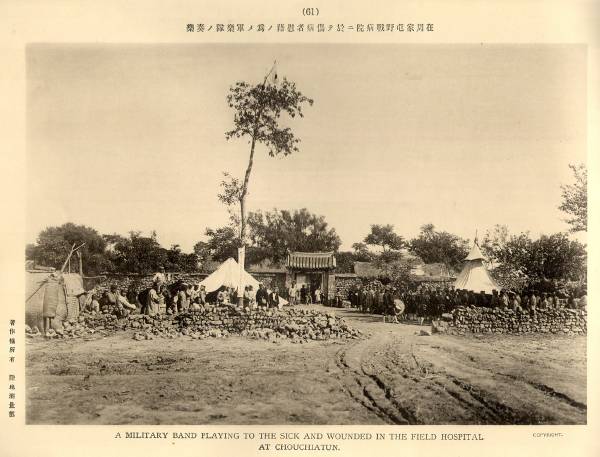 (62) A Russian 12-centimetre Canet gun mounted on the
central summit of the 174-metre Hill.
(63} A Russian heavy field gun and a powder magazine
on the western edge of the 174-metre Hill.
(64) A Russian 12-centimetre Canet gun mounted on the
eastern edge of the 174-metre Hill.
(65) Part of a store for captured shells collected in
a valley south of Ch'iuchiatun.
(66) Passage connecting two heavy guns and a
powder-magazine on the summit of the
174-metre Hill.
(67) A Russian Hotchkiss machine-gun found destroyed
in the centre of the 174-metre Hill.
(62) A Russian 12-centimetre Canet gun mounted on the
central summit of the 174-metre Hill.
(63} A Russian heavy field gun and a powder magazine
on the western edge of the 174-metre Hill.
(64) A Russian 12-centimetre Canet gun mounted on the
eastern edge of the 174-metre Hill.
(65) Part of a store for captured shells collected in
a valley south of Ch'iuchiatun.
(66) Passage connecting two heavy guns and a
powder-magazine on the summit of the
174-metre Hill.
(67) A Russian Hotchkiss machine-gun found destroyed
in the centre of the 174-metre Hill.
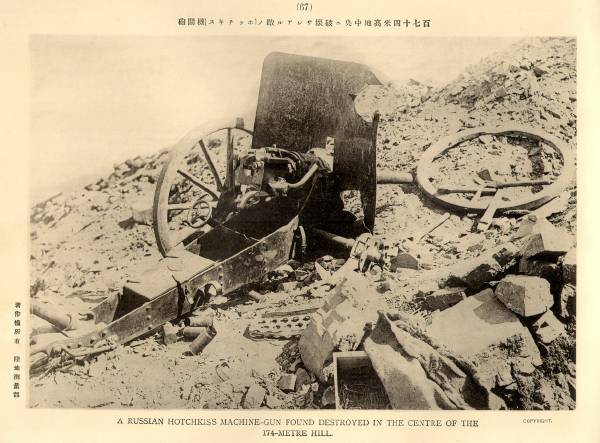 (68) A Russian machine gun mounted on the north-eastern
edge of 174-metre Hill.
(69) View of Tairen.
(70) The Second Field Hospital of the First Division
at Tawang-chuang.
(71) Soldiers slightly wounded resting on their way
to the rear on the south-eastern edge of Nihotzu.
(72) Part of the Naval Heavy Artillery Column and the
seriously-wounded soldiers being conveyed to the
rear on the northern edge of T'uchengtzu.
(68) A Russian machine gun mounted on the north-eastern
edge of 174-metre Hill.
(69) View of Tairen.
(70) The Second Field Hospital of the First Division
at Tawang-chuang.
(71) Soldiers slightly wounded resting on their way
to the rear on the south-eastern edge of Nihotzu.
(72) Part of the Naval Heavy Artillery Column and the
seriously-wounded soldiers being conveyed to the
rear on the northern edge of T'uchengtzu.
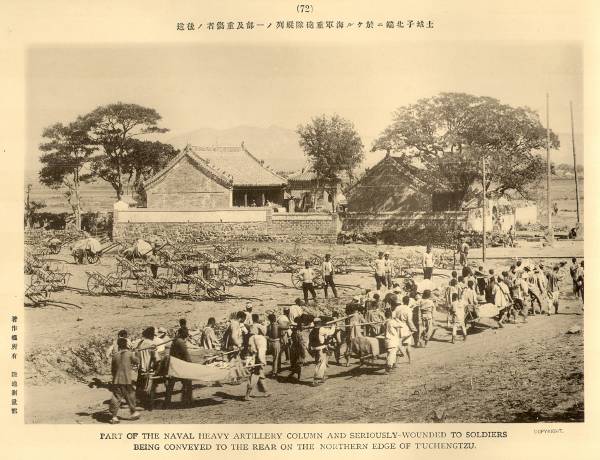 (73) Collection of materials for the Siege Engineers
Headquarters at Chouchiatung.
(74) The Staff of the Siege Artillery Headquarters on
a hill south-east of Fenghuang Hill.
(75) Interior of a Field Post-office at Chouchiatun.
(76) The Siege Artillery Headquarters on a hill
south-east of Feng-huang Hill.
(77) Russian eight-centimetre guns captured behind the
right wing of the forts of the First Foot
Artillery Regiment.
(78) Preparations for action on the First and Second
Forts of the First Foot Artillery Regiment on the
182-metre Hill southeast at Feng huang Hill.
(79) Transportation of provisions over a hill
south-east of Fenghuang Hill.
(73) Collection of materials for the Siege Engineers
Headquarters at Chouchiatung.
(74) The Staff of the Siege Artillery Headquarters on
a hill south-east of Fenghuang Hill.
(75) Interior of a Field Post-office at Chouchiatun.
(76) The Siege Artillery Headquarters on a hill
south-east of Feng-huang Hill.
(77) Russian eight-centimetre guns captured behind the
right wing of the forts of the First Foot
Artillery Regiment.
(78) Preparations for action on the First and Second
Forts of the First Foot Artillery Regiment on the
182-metre Hill southeast at Feng huang Hill.
(79) Transportation of provisions over a hill
south-east of Fenghuang Hill.
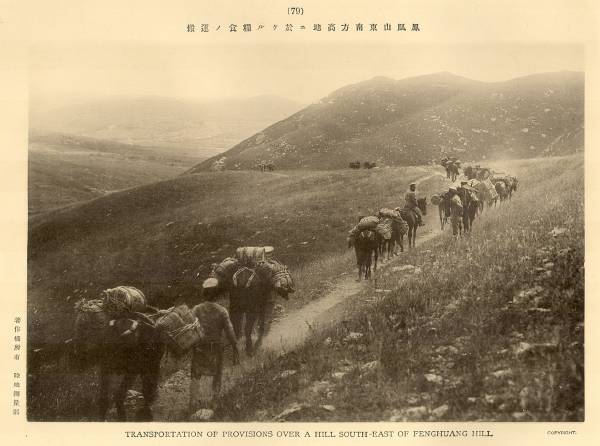 Colophon (Volume IX)
Colophon (Volume IX)
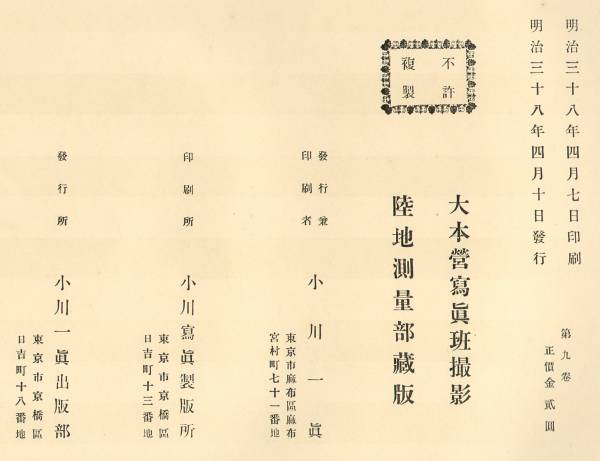 Printed Meiji 38 (1905).4.7
Published: Meiji 38 (1905).4.10
Printed Meiji 38 (1905).4.7
Published: Meiji 38 (1905).4.10
Volume X, Third Army, Part 4.
Covers
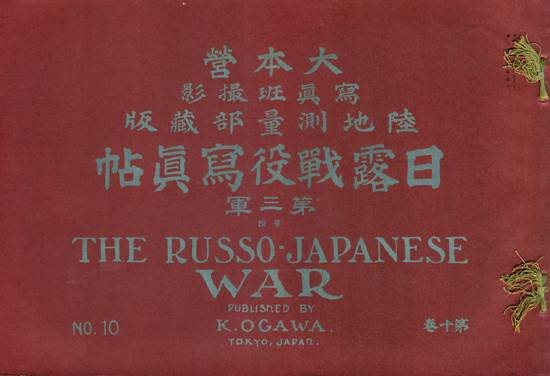
Title Page (English and Japanese)
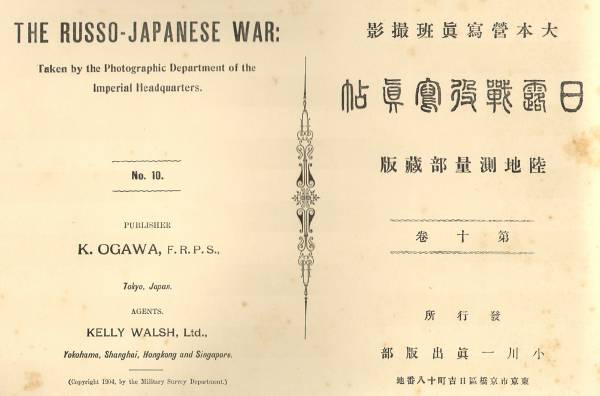 Contents Page (listing of plates)
Contents Page (listing of plates)
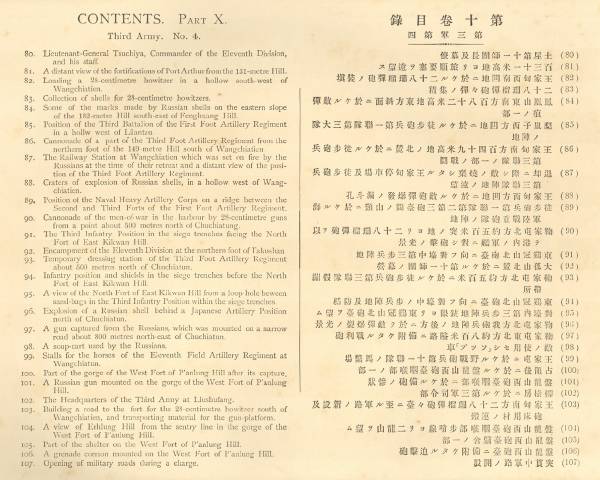 (80) Lieutenant-General Tsuchiya, Commander of the
Eleventh Division, and his staff.
(80) Lieutenant-General Tsuchiya, Commander of the
Eleventh Division, and his staff.
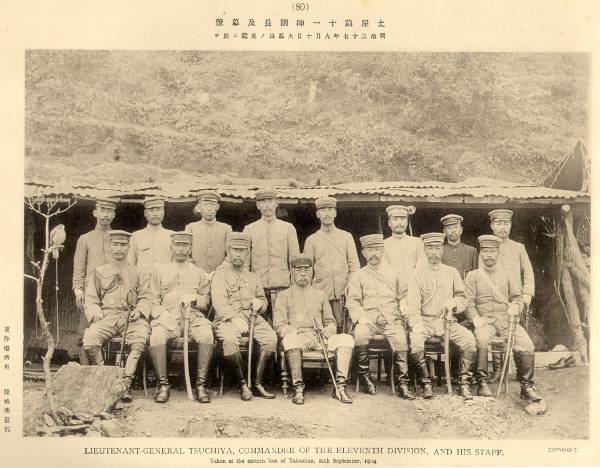 (8l A distant view of the fortifications of Port
Arthur from the 13 metre Hill.
(fold-out plate - 57 x 26.5 cm with tissue overlay)
(8l A distant view of the fortifications of Port
Arthur from the 13 metre Hill.
(fold-out plate - 57 x 26.5 cm with tissue overlay)
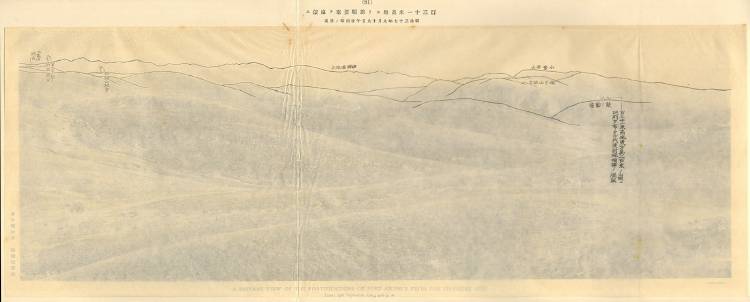 (82) Loading a 28-centimetre howitzer in a hollow
south-west of Wangchiatien.
(82) Loading a 28-centimetre howitzer in a hollow
south-west of Wangchiatien.
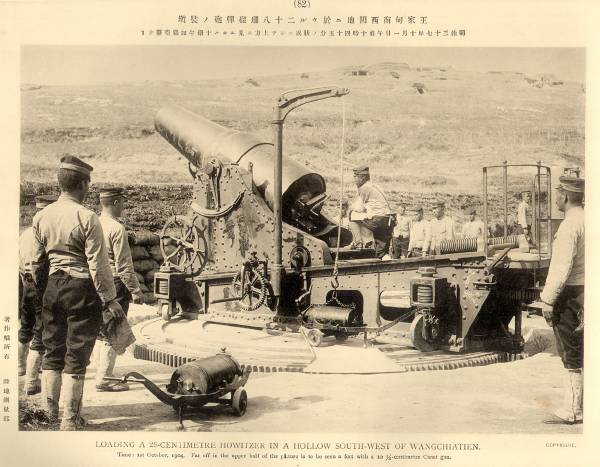 (83) Collection of shells for 28-centimetre howitzers.
(84) Some of the marks made by Russian shells on the
eastern slope of the 15 metre Hill south-east
of Fenghuang Hill.
(85) Position of the Third Battalion of the First Foot
Artillery Regiment in a hollow west of Lilantzu.
(86) Cannonade of a part of the Third Foot Artillery
Regiment from the northern foot of the 149-metre Hill
south of Wangchiatien.
(87) The Railway Station at Wangchiatien which was set on fire
by the Russians at the time of their retreat and a distant
view of the position of the Third Foot Artillery Regiment.
(83) Collection of shells for 28-centimetre howitzers.
(84) Some of the marks made by Russian shells on the
eastern slope of the 15 metre Hill south-east
of Fenghuang Hill.
(85) Position of the Third Battalion of the First Foot
Artillery Regiment in a hollow west of Lilantzu.
(86) Cannonade of a part of the Third Foot Artillery
Regiment from the northern foot of the 149-metre Hill
south of Wangchiatien.
(87) The Railway Station at Wangchiatien which was set on fire
by the Russians at the time of their retreat and a distant
view of the position of the Third Foot Artillery Regiment.
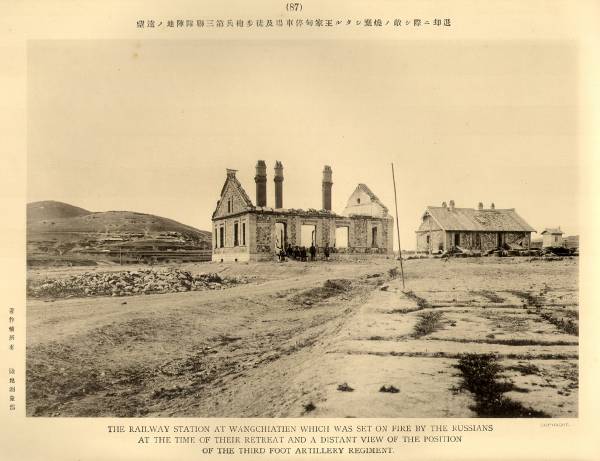 (88) Craters of explosion of Russian shells, in a
hollow west of Wangchiatien.
(89) Position of the Naval Heavy Artillery Corps on a
ridge between the Second and Third Forls of the
First Foot Artillery Regiment.
(90) Cannonade of the men-of-war in the harbour by
28-centimetre guns from a point about 500
metres north of Chuchiatucg.
(91) The Third Infantry Position in the siege trenches
facing the North Fort of East Kikwan Hill.
(92) Encampment of the Eleventh Division at the
northern foot of Takushan.
(93) Temporary dressing station of the Third Foot
Artillery Regiment about 500 metres north of
Chuchiatun.
(94) Infantry position and shields in the siege
trenches before the North Fort of East Kikwan Hill.
(95) A view of the North Fort of East Kikwan Hill
from a loop-hole between sand-bags in the Third
Infantry Position within the siege trenches.
(96) Explosion of a Russian shell behind a Japanese
Artillery Position north of Chuchiatun.
(97) A gun captured from the Russians, which was
mounted on a narrow road about 800 metres
north-east of Chuchiatun.
(88) Craters of explosion of Russian shells, in a
hollow west of Wangchiatien.
(89) Position of the Naval Heavy Artillery Corps on a
ridge between the Second and Third Forls of the
First Foot Artillery Regiment.
(90) Cannonade of the men-of-war in the harbour by
28-centimetre guns from a point about 500
metres north of Chuchiatucg.
(91) The Third Infantry Position in the siege trenches
facing the North Fort of East Kikwan Hill.
(92) Encampment of the Eleventh Division at the
northern foot of Takushan.
(93) Temporary dressing station of the Third Foot
Artillery Regiment about 500 metres north of
Chuchiatun.
(94) Infantry position and shields in the siege
trenches before the North Fort of East Kikwan Hill.
(95) A view of the North Fort of East Kikwan Hill
from a loop-hole between sand-bags in the Third
Infantry Position within the siege trenches.
(96) Explosion of a Russian shell behind a Japanese
Artillery Position north of Chuchiatun.
(97) A gun captured from the Russians, which was
mounted on a narrow road about 800 metres
north-east of Chuchiatun.
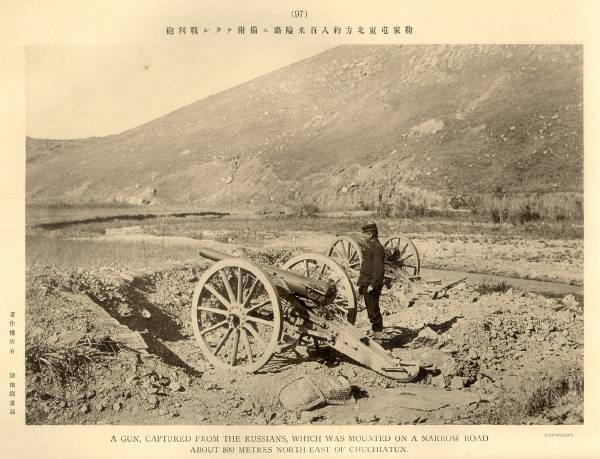 (98) A soup-cart used by the Russians.
(99) Stalls for the horses of the Eleventh Field
Artillery Regiment at Wangchiatun.
(100) Part of the gorge of the West Fort of P'anlung
Hill after its capture.
(101) The state of the defenses at the gorge of the
West Fort of P'anlung Hill.
(102) The Headquarters of the Third Army at Liushufang.
(103) Building a road to the fort for the 25-centimetre
howitzer south of Wangchiatien, and transporting
material for the gun-platform.
(98) A soup-cart used by the Russians.
(99) Stalls for the horses of the Eleventh Field
Artillery Regiment at Wangchiatun.
(100) Part of the gorge of the West Fort of P'anlung
Hill after its capture.
(101) The state of the defenses at the gorge of the
West Fort of P'anlung Hill.
(102) The Headquarters of the Third Army at Liushufang.
(103) Building a road to the fort for the 25-centimetre
howitzer south of Wangchiatien, and transporting
material for the gun-platform.
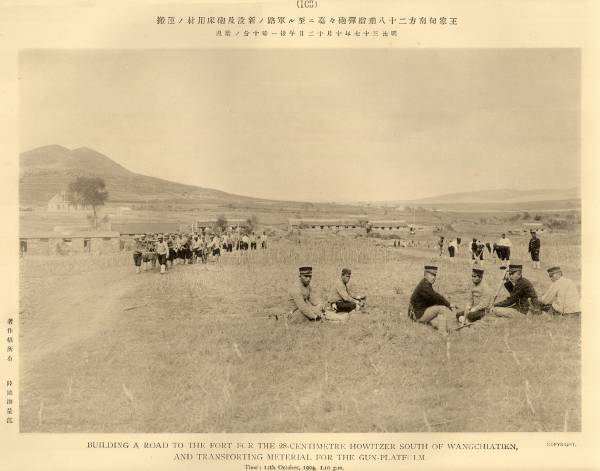 (104) A view of Erhlung Hill from the sentry line in
the gorge of the West Fort of P'anlung Hill.
(tissue overlay with topographical details)
(104) A view of Erhlung Hill from the sentry line in
the gorge of the West Fort of P'anlung Hill.
(tissue overlay with topographical details)
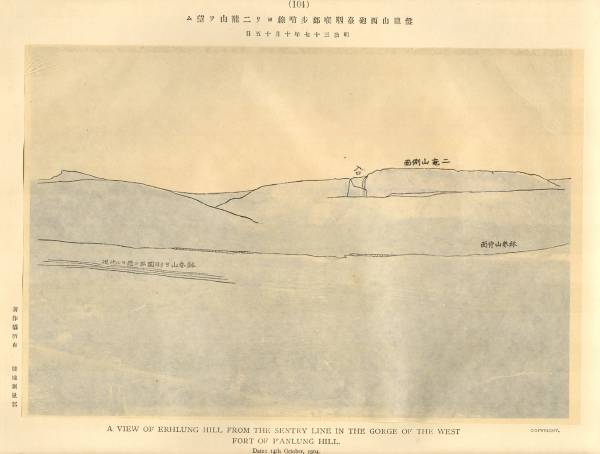 (105) Part of the shelter on the West Fort of P'anlung
Hill.
(106) A grenade cannon mounted on the West Fort of
P'anlung Hill.
(107) Opening of military roads during a charge.
(105) Part of the shelter on the West Fort of P'anlung
Hill.
(106) A grenade cannon mounted on the West Fort of
P'anlung Hill.
(107) Opening of military roads during a charge.
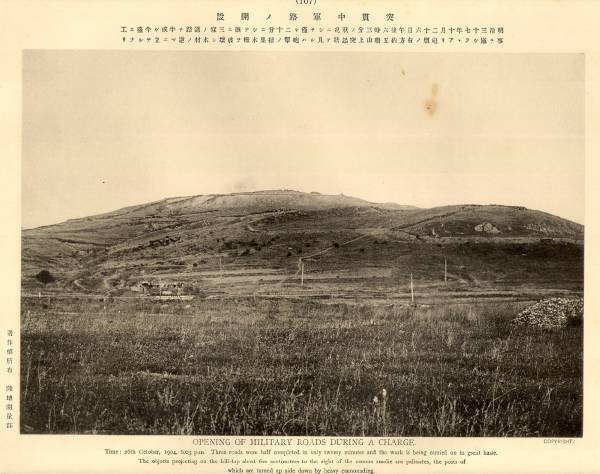 Colophon (Volume X)
Colophon (Volume X)
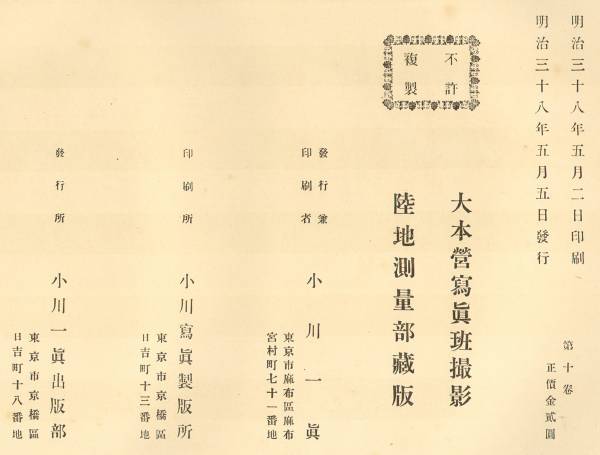 Printed Meiji 38 (1905).5.2
Published: Meiji 38 (1905).5.10
Printed Meiji 38 (1905).5.2
Published: Meiji 38 (1905).5.10
Volume XI, Third Army, Part 5.
Covers
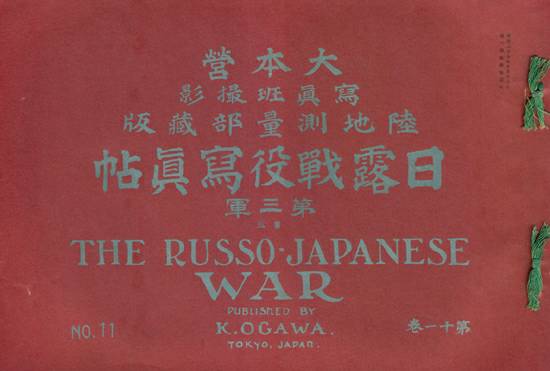
Title Page (English and Japanese)
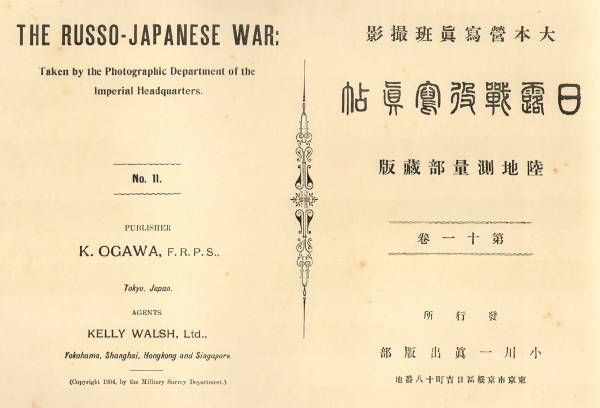 Contents Page (listing of plates)
Contents Page (listing of plates)
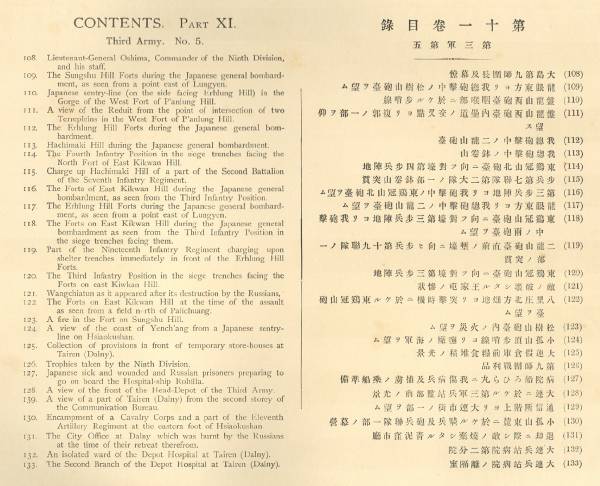 (108) Lieutenant-General Oshima, Commander of the Ninth
Division and his staff.
(108) Lieutenant-General Oshima, Commander of the Ninth
Division and his staff.
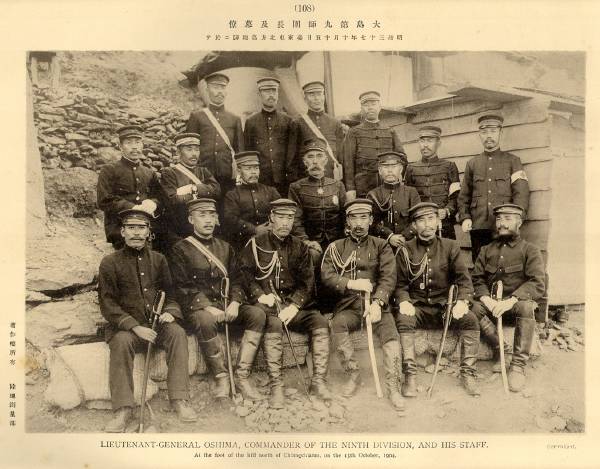 (109) The Sungshu Hill Forts during the Japanese general
bombardment, as seen from a point east of Lungyen.
(fold-out plate - 60 x 26.5 cm with tissue overlay)
(109) The Sungshu Hill Forts during the Japanese general
bombardment, as seen from a point east of Lungyen.
(fold-out plate - 60 x 26.5 cm with tissue overlay)
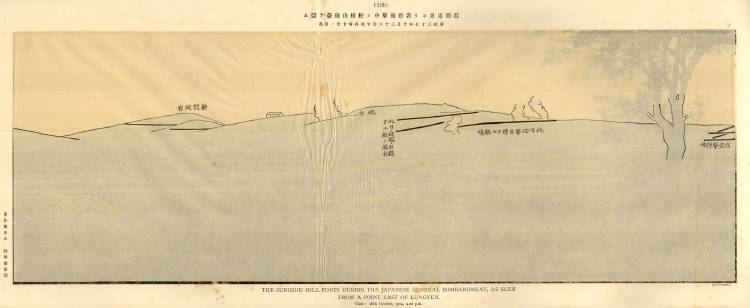 (110) Japanese sentry-line (on the side facing Erhlung
Hill) in the gorge of the West Fort of P'anlung
Hill.
(111) A view of the reduit from the point of
intersection of two terrepleins in the West Fort
of P'anlung Hill.
(112) The Erhlung Hill Forts during the Japanese
general bombardment.
(tissue overlay)
(110) Japanese sentry-line (on the side facing Erhlung
Hill) in the gorge of the West Fort of P'anlung
Hill.
(111) A view of the reduit from the point of
intersection of two terrepleins in the West Fort
of P'anlung Hill.
(112) The Erhlung Hill Forts during the Japanese
general bombardment.
(tissue overlay)
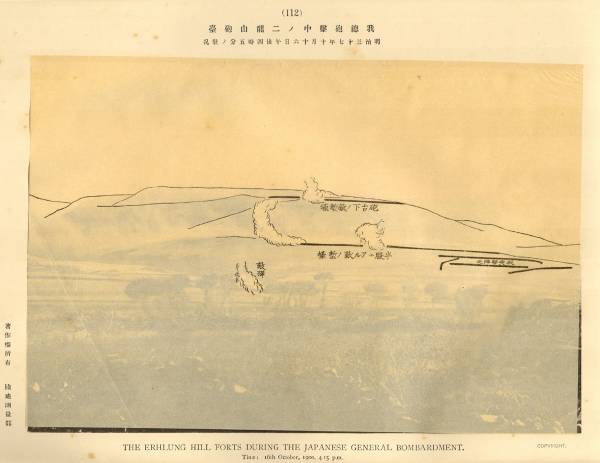 (113) Hachimaki Hill during the Japanese general
bombardment.
(114) The Fourth Infantry Position in the siege
trenches facing the North Fort of East
Kikwan Hill.
(115) Charge up Hachimaki Hill of a part of the Second
Battalion of the Seventh Infantry Regiment.
(tissue overlay)
(113) Hachimaki Hill during the Japanese general
bombardment.
(114) The Fourth Infantry Position in the siege
trenches facing the North Fort of East
Kikwan Hill.
(115) Charge up Hachimaki Hill of a part of the Second
Battalion of the Seventh Infantry Regiment.
(tissue overlay)
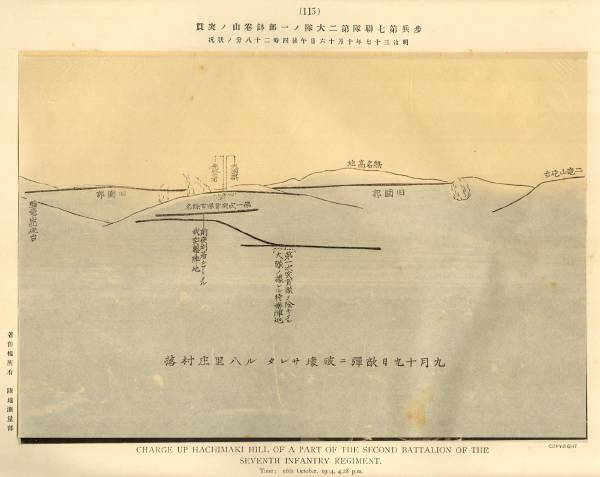 (116) The North Fort of East Kikwan Hill during the
Japanese general bombardment, as seen from the
Third Infantry Position.
(117) The Erhlung Hill Forts during the Japanese general
bombardment, as seen from a point east of Lungyen.
(116) The North Fort of East Kikwan Hill during the
Japanese general bombardment, as seen from the
Third Infantry Position.
(117) The Erhlung Hill Forts during the Japanese general
bombardment, as seen from a point east of Lungyen.
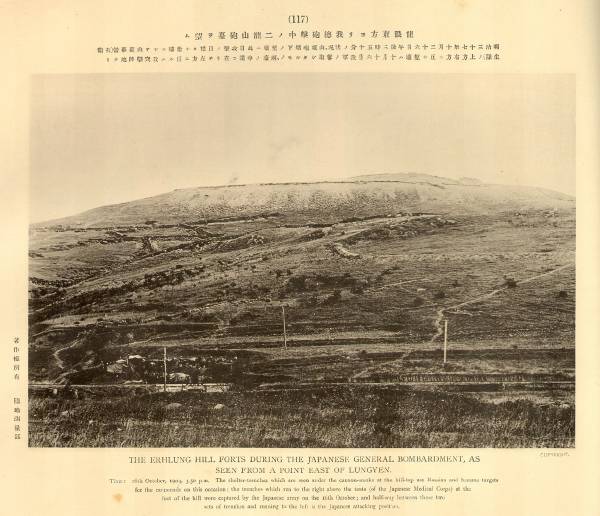 (118) The Forts on East Kikwan Hill during the Japanese
general bombardment, as seen from the Third
Infantry Position in the siege trenches facing
them.
(119) Part of the Nineteenth Infantry Regiment charging
upon shelter trenches immediately in front of
the Erhlung Hill Forts.
(120) The Third Infantry Position in the siege trenches
facing the Forts on the East Kikwan Hill.
(121) Wangchiatun as it appeared after its destruction
by the Russians.
(118) The Forts on East Kikwan Hill during the Japanese
general bombardment, as seen from the Third
Infantry Position in the siege trenches facing
them.
(119) Part of the Nineteenth Infantry Regiment charging
upon shelter trenches immediately in front of
the Erhlung Hill Forts.
(120) The Third Infantry Position in the siege trenches
facing the Forts on the East Kikwan Hill.
(121) Wangchiatun as it appeared after its destruction
by the Russians.
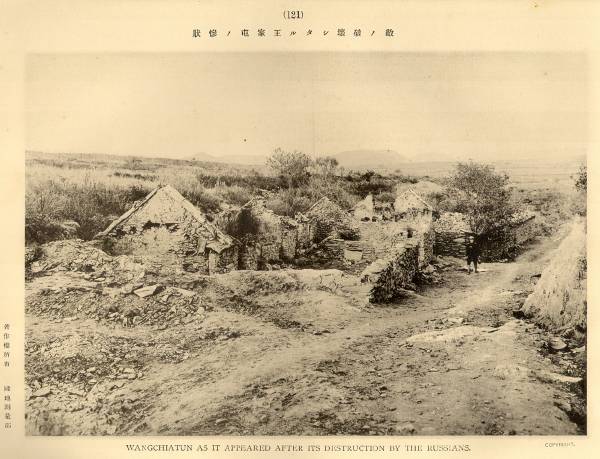 (122) The Forts on East Kikwan Hill at the time of the
assault as seen from a field north of Palicbuang.
(123) A fire in the Fort on Sungshu Hill.
(124) A view of the coast of Yench'ang from a Japanese
sentry-line on Hsiaokushan.
(125) Collection of provisions in front of temporary
store-houses at Tairen (Dalny).
(126) Trophies taken by the Ninth Division.
(122) The Forts on East Kikwan Hill at the time of the
assault as seen from a field north of Palicbuang.
(123) A fire in the Fort on Sungshu Hill.
(124) A view of the coast of Yench'ang from a Japanese
sentry-line on Hsiaokushan.
(125) Collection of provisions in front of temporary
store-houses at Tairen (Dalny).
(126) Trophies taken by the Ninth Division.
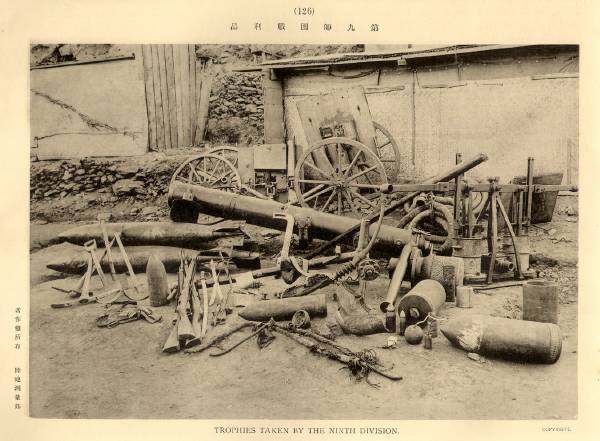 (127) Japanese sick and wounded and Russian prisoners
preparing to go on board the Hospital-ship Rohilla.
(128) A view of the front of the Head-Depot of the
Third Army at Tairen (Dalny}.
(129) A view of a part of Tairen (Dalny) from the
second story of the Communication Bureau.
(127) Japanese sick and wounded and Russian prisoners
preparing to go on board the Hospital-ship Rohilla.
(128) A view of the front of the Head-Depot of the
Third Army at Tairen (Dalny}.
(129) A view of a part of Tairen (Dalny) from the
second story of the Communication Bureau.
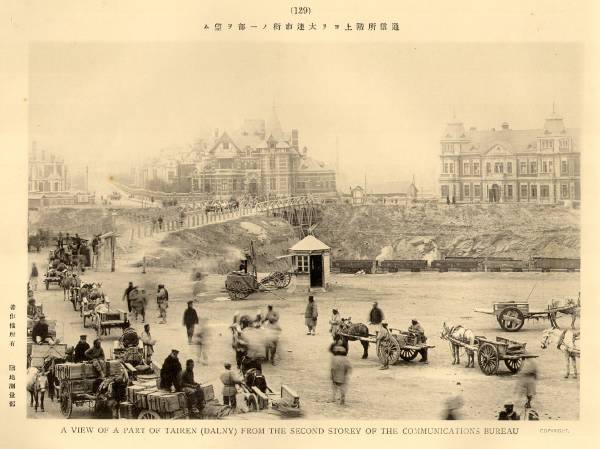 (130) Encampment of Cavalry Corps and a part of the
Eleventh Artillery Regiment at the eastern foot
of Hsiaokushan.
(131) The City Office at Dalny which was burnt by the
Russians at the time of their retreat therefrom.
(130) Encampment of Cavalry Corps and a part of the
Eleventh Artillery Regiment at the eastern foot
of Hsiaokushan.
(131) The City Office at Dalny which was burnt by the
Russians at the time of their retreat therefrom.
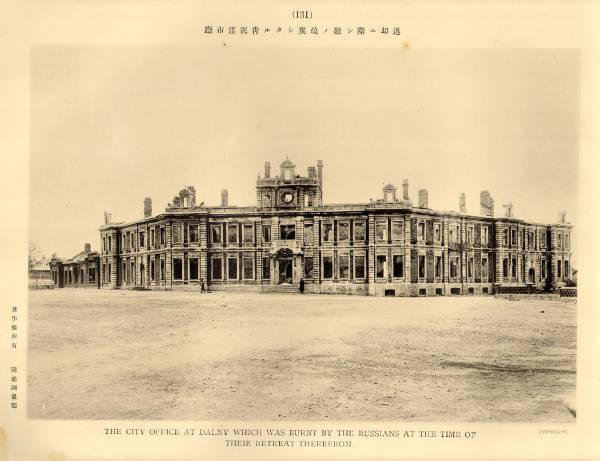 (132) The Second Branch of the Depot Hospital at
Tairen (Dalny).
(133) An isolated ward of the Dept Hospital at Tairen (Dalny).
(132) The Second Branch of the Depot Hospital at
Tairen (Dalny).
(133) An isolated ward of the Dept Hospital at Tairen (Dalny).
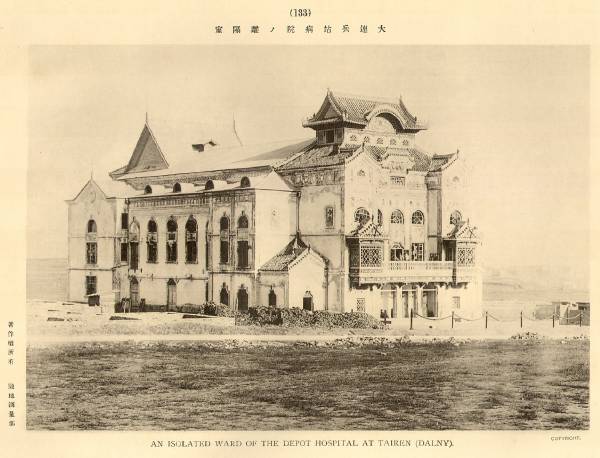 Colophon (Volume XI)
Colophon (Volume XI)
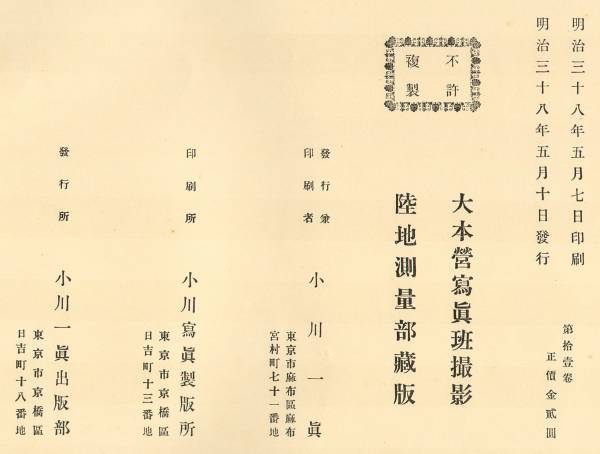 Printed Meiji 38 (1905).5.7
Published: Meiji 38 (1905).5.10
Printed Meiji 38 (1905).5.7
Published: Meiji 38 (1905).5.10
Volume XII, Third Army, Part 6.
Covers
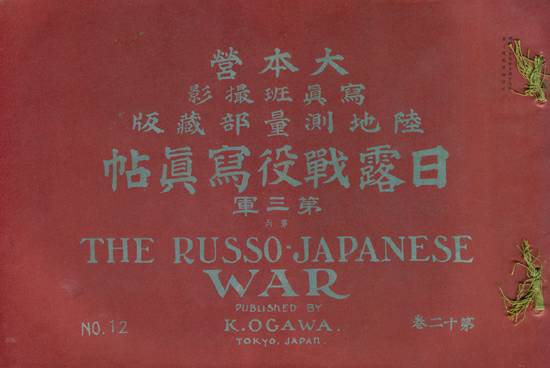
Title Page (English and Japanese)
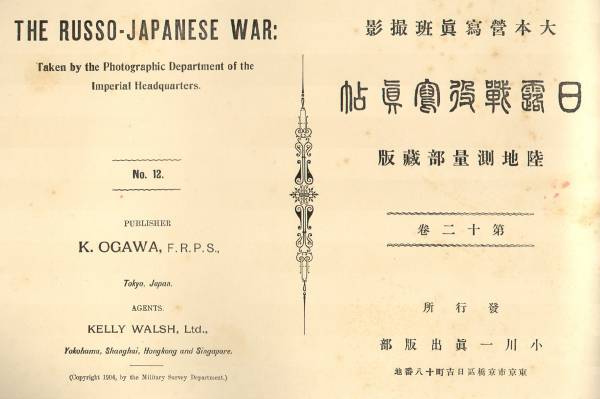 Contents Page (listing of plates)
Contents Page (listing of plates)
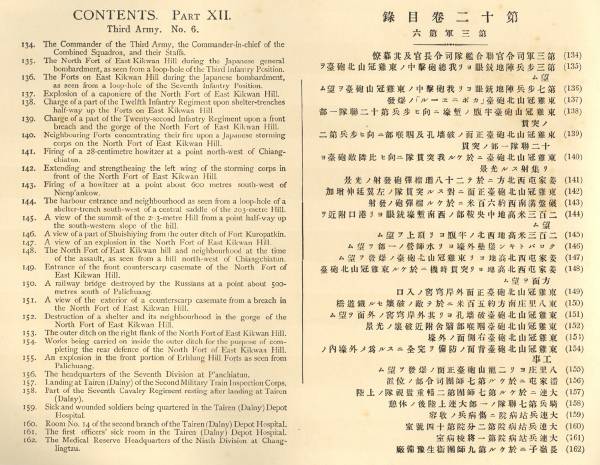 (134) The Commander of the Third Army, the Commander-in-chief
of the Combined Squadron, and their Staffs.
(134) The Commander of the Third Army, the Commander-in-chief
of the Combined Squadron, and their Staffs.
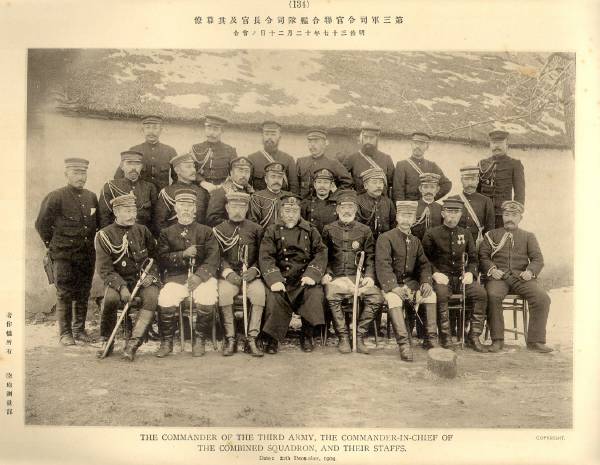 (135) The North Fort of East Kikwan Hill during the
Japanese general bombardment, as seen from a
loop-hole of the Third Infantry Position.
(136) The Forts on East Kikwan Hill during the Japanese
bombardment, as seen from a loop-hole of the
Seventh Infantry Position.
(137) Explosion of a caponiere of the North Fort of
East Kikwan Hill.
(135) The North Fort of East Kikwan Hill during the
Japanese general bombardment, as seen from a
loop-hole of the Third Infantry Position.
(136) The Forts on East Kikwan Hill during the Japanese
bombardment, as seen from a loop-hole of the
Seventh Infantry Position.
(137) Explosion of a caponiere of the North Fort of
East Kikwan Hill.
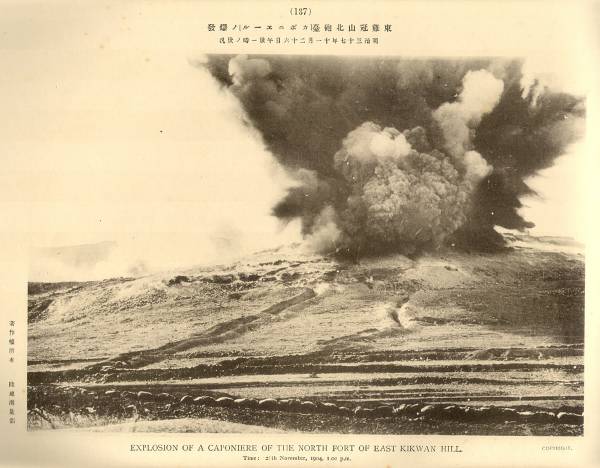 (138) Charge of a part of the Twelfth Infantry Regiment
upon shelter-trenches half-way up the Forts on
East Kikwan Hill.
(139) Charge of a part of the Twenty-second Infantry
Regiment upon a front breach and the gorge of
the North Fort of East Kikwan Hill.
(140) Neighbouring Forts concentrating their fire upon
a Japanese storming corps on the North Fort
of East Kikwan Hill.
(141) Firing of a 28-centimetre howitzer at a point
north-west of Chiangchiatun.
(142) Extending and strengthening the left wing of the
storming corps in front of the North Fort of
East Kikwan Hill.
(143) Firing of a howitzer at a point about 600 metres
south-west of Nienp'ankow.
(144) The harbour entrance and neighbourhood as seen
from a loop-hole of a shelter-trench south-west
of a central saddle of the 203-metre Hill.
(tissue overlay)
(138) Charge of a part of the Twelfth Infantry Regiment
upon shelter-trenches half-way up the Forts on
East Kikwan Hill.
(139) Charge of a part of the Twenty-second Infantry
Regiment upon a front breach and the gorge of
the North Fort of East Kikwan Hill.
(140) Neighbouring Forts concentrating their fire upon
a Japanese storming corps on the North Fort
of East Kikwan Hill.
(141) Firing of a 28-centimetre howitzer at a point
north-west of Chiangchiatun.
(142) Extending and strengthening the left wing of the
storming corps in front of the North Fort of
East Kikwan Hill.
(143) Firing of a howitzer at a point about 600 metres
south-west of Nienp'ankow.
(144) The harbour entrance and neighbourhood as seen
from a loop-hole of a shelter-trench south-west
of a central saddle of the 203-metre Hill.
(tissue overlay)
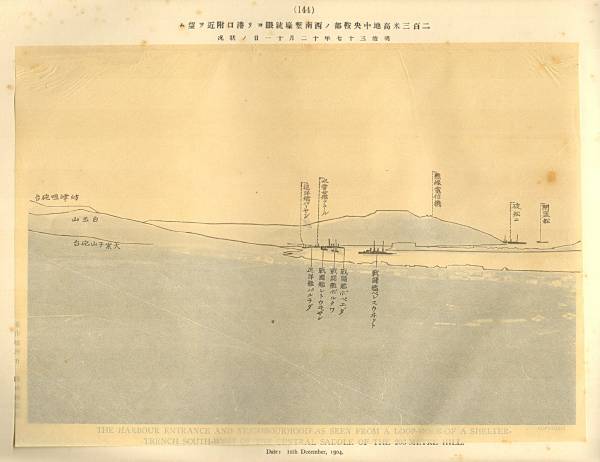 (145) A view of the summit of the 203-metre Hill from a point
half-way up the south-western slope of the hill.
(tissue overlay)
(145) A view of the summit of the 203-metre Hill from a point
half-way up the south-western slope of the hill.
(tissue overlay)
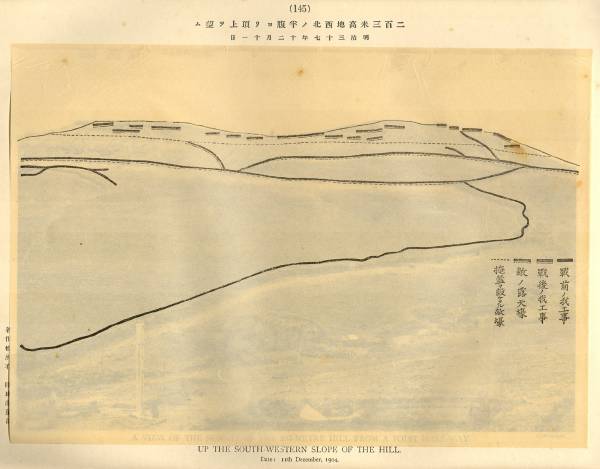 (146) A view of a part of Shuishiying from the outer
ditch of Fort Kuropatkin.
(147) A view of an explosion in the North Fort of
East Kikwan Hill from a hill north-east of
Chiangchiatun.
(148) The North Fort of East Kikwan Hill and
neighbourhood at the time of the assault,
as seen from a hill north-west of Chiangchiatun.
(149) Entrance of the front counterscarp casement of
the North Fort of East Kikwan Hill.
(150) A railway bridge destroyed by the Russians at a
point about 500-metres south of Palichuang.
(146) A view of a part of Shuishiying from the outer
ditch of Fort Kuropatkin.
(147) A view of an explosion in the North Fort of
East Kikwan Hill from a hill north-east of
Chiangchiatun.
(148) The North Fort of East Kikwan Hill and
neighbourhood at the time of the assault,
as seen from a hill north-west of Chiangchiatun.
(149) Entrance of the front counterscarp casement of
the North Fort of East Kikwan Hill.
(150) A railway bridge destroyed by the Russians at a
point about 500-metres south of Palichuang.
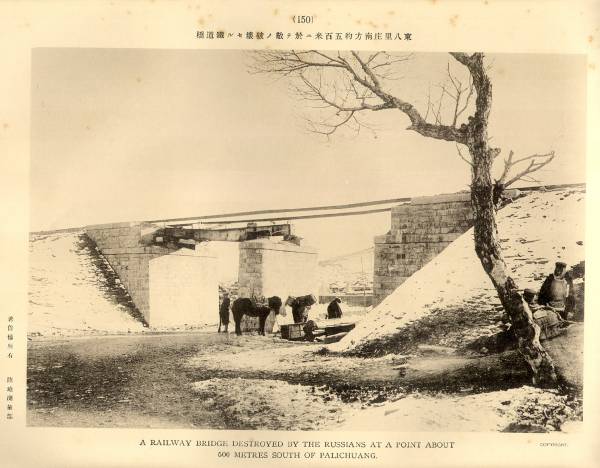 (151) A view of the exterior of a counter a scarp casement
from a breach in the North Fort of East Kikwaa Hill.
(152) Destruction of a shelter and its neighbourhood
in the gorge of the North Fort of East Kikwan Hill.
(153) The outer ditch on the right flank of the North
Fort of East Kikwan Hill.
(154} Works being carried on inside the outer ditch for
the purpose of completing the rear defence of the
North Fort of East Kikwan Hill.
(155) An explosion in the front portion of Erhlisng
Hilt Forts as seen from Palichuang.
(156) The headquarters of the Seventh Division at Fanchiatun.
(157) Landing at Tairen (Dalny) of the Second Military
Train Inspection Corps.
(151) A view of the exterior of a counter a scarp casement
from a breach in the North Fort of East Kikwaa Hill.
(152) Destruction of a shelter and its neighbourhood
in the gorge of the North Fort of East Kikwan Hill.
(153) The outer ditch on the right flank of the North
Fort of East Kikwan Hill.
(154} Works being carried on inside the outer ditch for
the purpose of completing the rear defence of the
North Fort of East Kikwan Hill.
(155) An explosion in the front portion of Erhlisng
Hilt Forts as seen from Palichuang.
(156) The headquarters of the Seventh Division at Fanchiatun.
(157) Landing at Tairen (Dalny) of the Second Military
Train Inspection Corps.
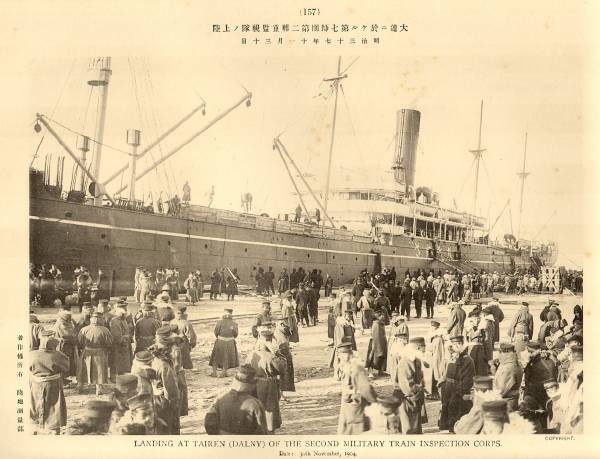 (158) Part of the Seventh Cavalry Regiment resting
after landing at Tairen (Dalny).
(159) Sick and wounded soldiers being quartered in the
Tairen (Dalny) Depot Hospital.
(160) Room No. 14 of the Second Branch of the Tairen
(Dalny) Depot Hospital.
(161) The first officers' sick room in the Tairen
(Dalny] Depot Hospital.
(158) Part of the Seventh Cavalry Regiment resting
after landing at Tairen (Dalny).
(159) Sick and wounded soldiers being quartered in the
Tairen (Dalny) Depot Hospital.
(160) Room No. 14 of the Second Branch of the Tairen
(Dalny) Depot Hospital.
(161) The first officers' sick room in the Tairen
(Dalny] Depot Hospital.
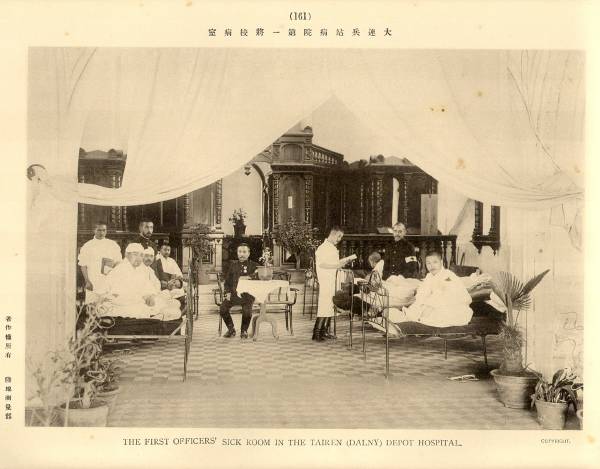 (162) The Medical Reserve Headquarters of the Ninth
Division at Cbanglingtzu.
Colophon (Volume XII)
(162) The Medical Reserve Headquarters of the Ninth
Division at Cbanglingtzu.
Colophon (Volume XII)
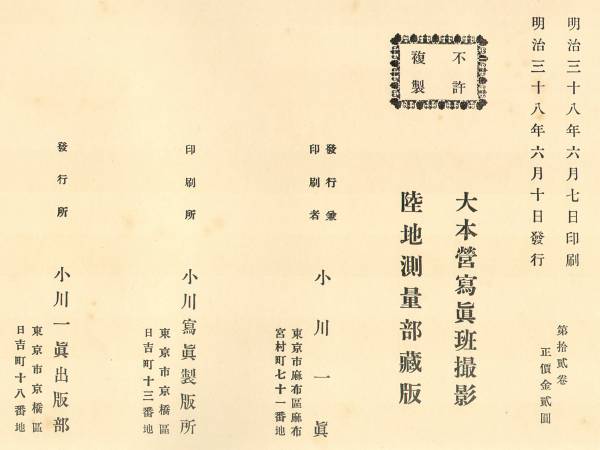 Printed Meiji 38 (1905).6.7
Published: Meiji 38 (1905).6.10
Printed Meiji 38 (1905).6.7
Published: Meiji 38 (1905).6.10
Volume XIII, Third Army, Part 7.
Covers
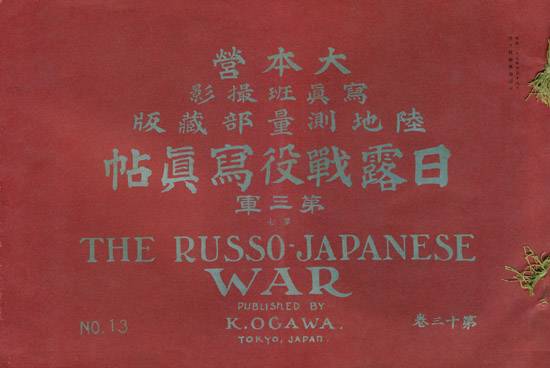
Title Page (English and Japanese)
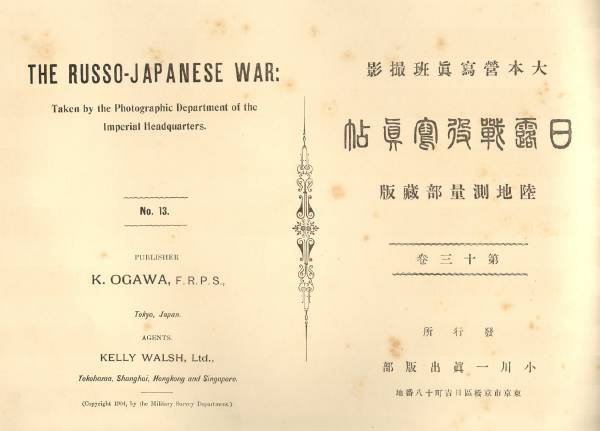 Contents Page (listing of plates)
Contents Page (listing of plates)
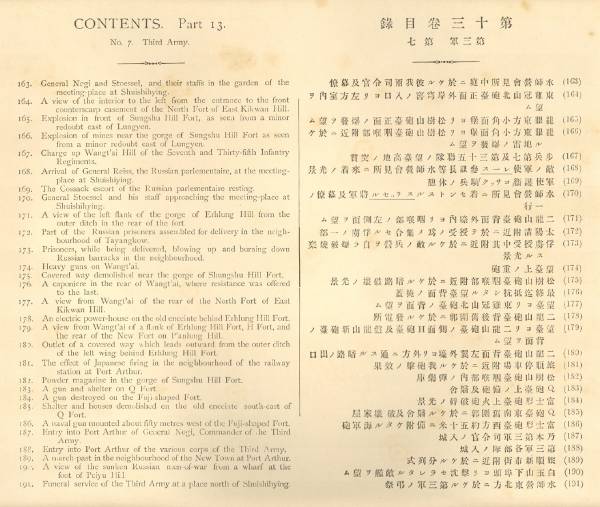 (163) Generals Nogi and Stoessel, and their staffs in
the garden of the meeting-place at Shuishihying.
(163) Generals Nogi and Stoessel, and their staffs in
the garden of the meeting-place at Shuishihying.
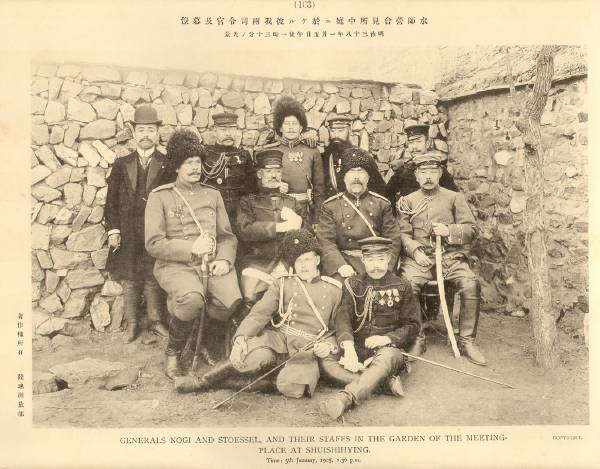 (164) A view of the interior to the left from the
entrance to the front counterscarp casement of
the North Fort of East Kikwan Hill.
(165) Explosion in front of Sungshu Hill Fort, as seen
from a minor redoubt east of Lungyen.
(166) Explosion of mines near the gorge of Sungshu Hill
Fort as seen from a minor redoubt east of Lungyen.
(167) Charge up Wangt'ai Hill of the Seventh and
Thirty-fifth Infantry Regiments.
(168) Arrival of General Reiss, the Russian
parlamentaire, at the meeting-place at Shuishiying.
(169) The Cossack escort of the Russian parlementaire resting.
(164) A view of the interior to the left from the
entrance to the front counterscarp casement of
the North Fort of East Kikwan Hill.
(165) Explosion in front of Sungshu Hill Fort, as seen
from a minor redoubt east of Lungyen.
(166) Explosion of mines near the gorge of Sungshu Hill
Fort as seen from a minor redoubt east of Lungyen.
(167) Charge up Wangt'ai Hill of the Seventh and
Thirty-fifth Infantry Regiments.
(168) Arrival of General Reiss, the Russian
parlamentaire, at the meeting-place at Shuishiying.
(169) The Cossack escort of the Russian parlementaire resting.
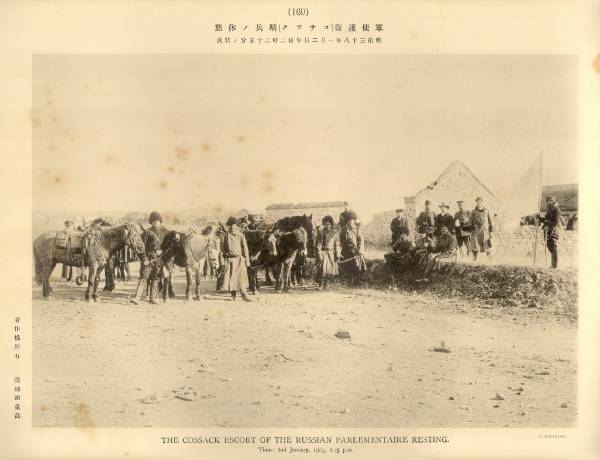 (170) General Stoessel and his staff approaching the
meet Ing-pi ace at Shuishiying.
(171) A view of the flank of the gorge of Erhlung Hill
Fort from the outer ditch in the rear of the Fort.
(172) Part of the Russian prisoners assembled for
delivery in the neighbourhood of Tayangkow.
(173) Prisoners, while being delivered, blowing up and
burning down Russian barracks in the neighbourhood.
(174) Heavy guns at Wangt'ai.
(175) Covered way demolished near the gorge of Sungshu
Hill Fort.
(176) A caponiere in the rear of Wangt'ai, where
resistance was offered, to the last.
(177) A view from Wangt'ai of the rear of the North
Fort of East Kikwan Kill.
(178) A electric power-house on the old enceinte
behind Erhlung Hill Fort.
(170) General Stoessel and his staff approaching the
meet Ing-pi ace at Shuishiying.
(171) A view of the flank of the gorge of Erhlung Hill
Fort from the outer ditch in the rear of the Fort.
(172) Part of the Russian prisoners assembled for
delivery in the neighbourhood of Tayangkow.
(173) Prisoners, while being delivered, blowing up and
burning down Russian barracks in the neighbourhood.
(174) Heavy guns at Wangt'ai.
(175) Covered way demolished near the gorge of Sungshu
Hill Fort.
(176) A caponiere in the rear of Wangt'ai, where
resistance was offered, to the last.
(177) A view from Wangt'ai of the rear of the North
Fort of East Kikwan Kill.
(178) A electric power-house on the old enceinte
behind Erhlung Hill Fort.
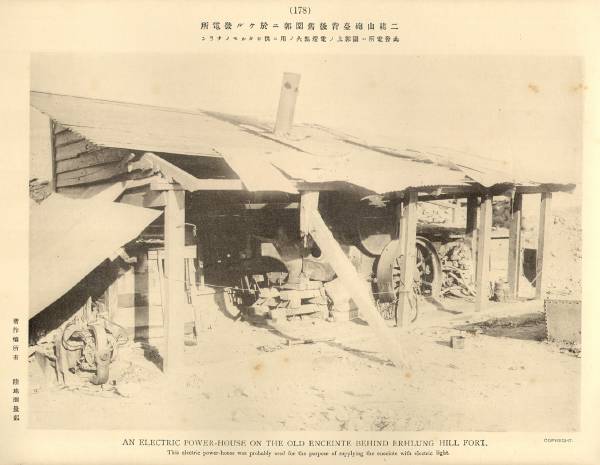 (179) A view from Wangt'ai of a flank of Erhlung Hill
Fort, H Fort and the rear of the New Fort on
P'anlung Hill.
(180) Outlet of a covered way which leads outward from
the outer ditch of the left wing behind Erhlung
Hill Fort.
(181) The effect of Japanese tiring in the neighbourhood
of the railway station at Port Arthur.
(179) A view from Wangt'ai of a flank of Erhlung Hill
Fort, H Fort and the rear of the New Fort on
P'anlung Hill.
(180) Outlet of a covered way which leads outward from
the outer ditch of the left wing behind Erhlung
Hill Fort.
(181) The effect of Japanese tiring in the neighbourhood
of the railway station at Port Arthur.
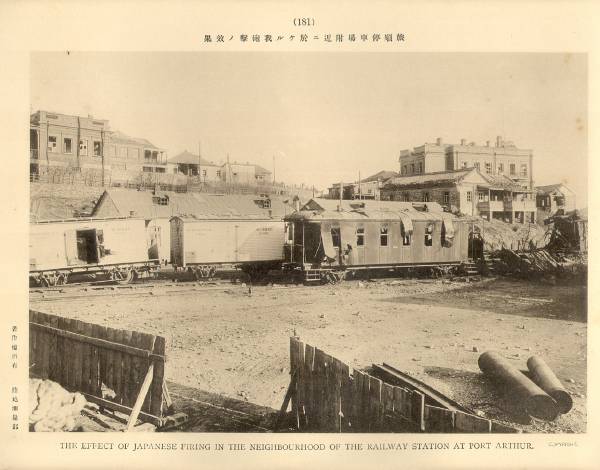 (182) Powder magazine in the gorge of Sungshu Hill Fort.
(183) A gun and shelter on Q Fort,
(184) A gun destroyed on the Fuji-shaped Fort.
(185) Shelter and houses demolished on the old enceinte
south-east of Q Fort.
(186) A naval gun mounted about fifty metres west of
Fuji-shaped Fort.
(182) Powder magazine in the gorge of Sungshu Hill Fort.
(183) A gun and shelter on Q Fort,
(184) A gun destroyed on the Fuji-shaped Fort.
(185) Shelter and houses demolished on the old enceinte
south-east of Q Fort.
(186) A naval gun mounted about fifty metres west of
Fuji-shaped Fort.
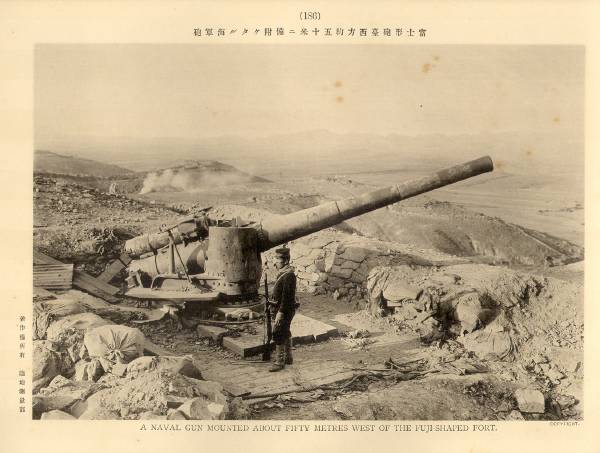 (187) Entry into Port Arthur of General Nogi,
Commander of the Third Army.
(187) Entry into Port Arthur of General Nogi,
Commander of the Third Army.
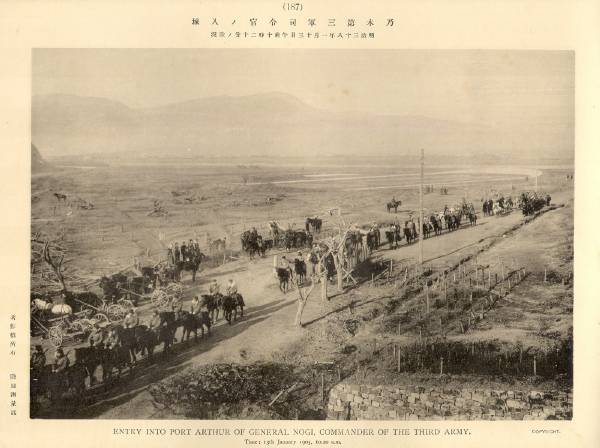 (188) Entry into Port Arthur of various corps of the
Third Army.
(189) A march-past in the neighbourhood of the New Town
at Port Arthur.
(190) A view of sunken Russian men-of-war from a wharf
at the foot of Peiyu Hill.
(188) Entry into Port Arthur of various corps of the
Third Army.
(189) A march-past in the neighbourhood of the New Town
at Port Arthur.
(190) A view of sunken Russian men-of-war from a wharf
at the foot of Peiyu Hill.
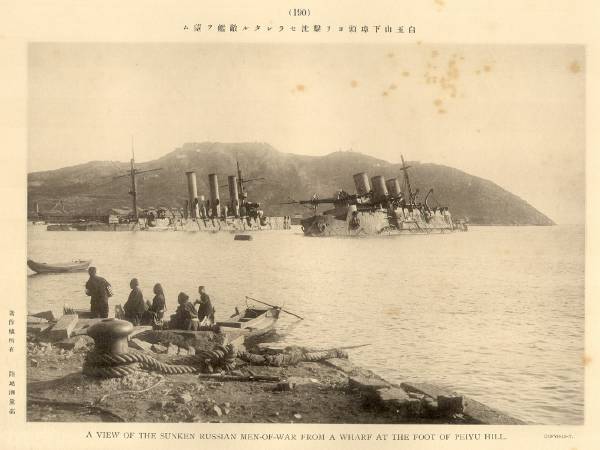 (191) Funeral service of the Third Army at a place
north of Shuishiying.
(191) Funeral service of the Third Army at a place
north of Shuishiying.
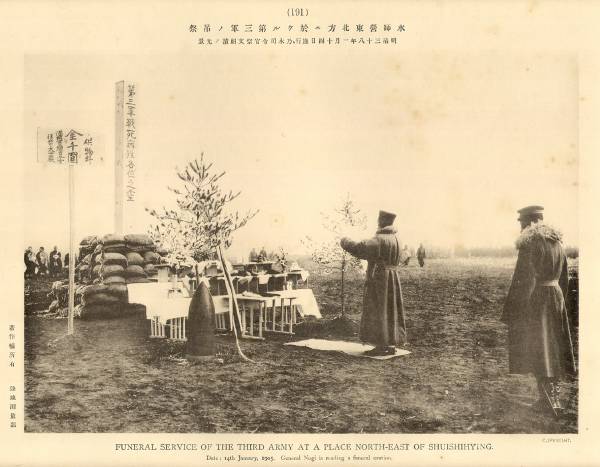 Colophon (Volume XIII)
Colophon (Volume XIII)
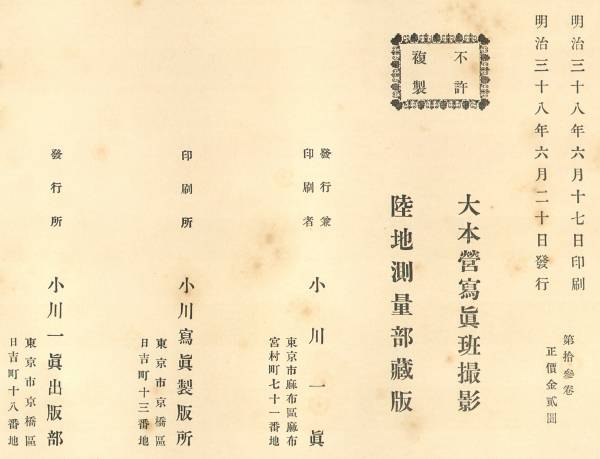 Printed Meiji 38 (1905).6.17
Published: Meiji 38 (1905).6.20
Printed Meiji 38 (1905).6.17
Published: Meiji 38 (1905).6.20
Volume XIV, Third Army, Part 8.
Covers
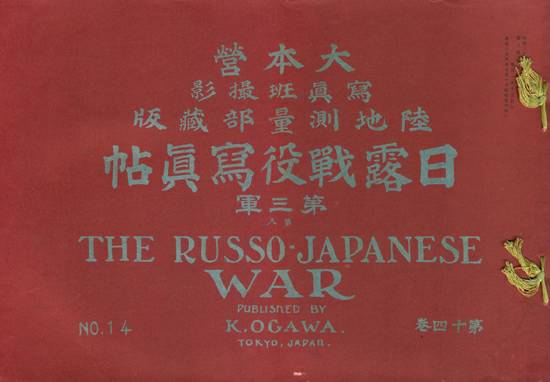
Title Page (English and Japanese)
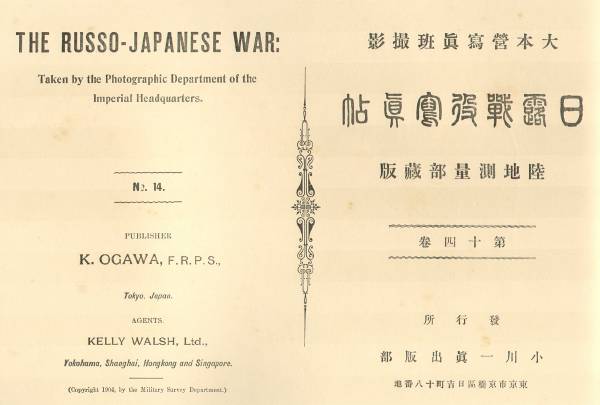 Contents Page (listing of plates)
Contents Page (listing of plates)
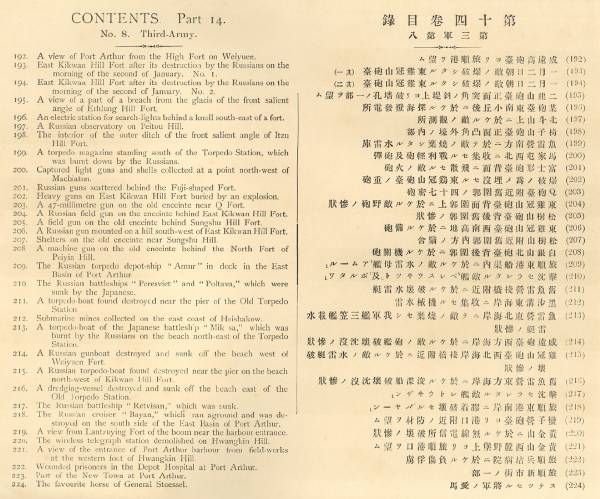 (192) A view of Port Arthur from the High Fort on Weiyuen.
(fold-out plate - 62 x 26.5 cm)
(192) A view of Port Arthur from the High Fort on Weiyuen.
(fold-out plate - 62 x 26.5 cm)
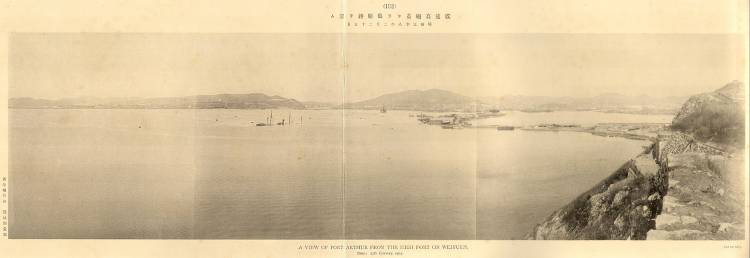 (193) East Kikwan Hill Fort after its destruction by
the Russians on the morning of the second of
January. No. 1.
(194) East Kikwan Hill Fort after its destruction by
the Russians on the morning of the second of
January. No. 2.
(195) A view of a part of a breach from the glacis of
the front salient angle of Erhlung Ilill Fort.
(196) An electric station for search-lights behind a
knoll south-cast of a fort.
(197) A Russian observatory on Peitou Hill.
(193) East Kikwan Hill Fort after its destruction by
the Russians on the morning of the second of
January. No. 1.
(194) East Kikwan Hill Fort after its destruction by
the Russians on the morning of the second of
January. No. 2.
(195) A view of a part of a breach from the glacis of
the front salient angle of Erhlung Ilill Fort.
(196) An electric station for search-lights behind a
knoll south-cast of a fort.
(197) A Russian observatory on Peitou Hill.
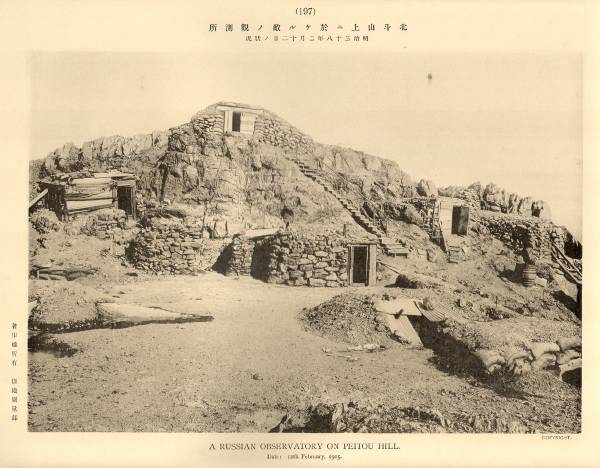 (198) The interior of the outer ditch of the front
salient angle of Itzu Hill Fort.
(199) A torpedo magazine standing south of the Torpedo
Station, which was burnt down by the Russians.
(200) Captured light guns and shells collected at a
point north-west of Machiaiun.
(201) Russian guns scattered behind the
Fuji-shaped Fort.
(202) Heavy guns on East Kikwan Hill Fort buried by
an explosion.
(203) A 47-millimtre gun on the old enceinte near
Q Fort.
(204) A Russian field gun on the enceinte behind East
Kikwan Hill Fort.
(205) A field gun on the old enceinte behind Sungshu
Hill Fort.
(206) A Russian gun mounted on a hill south-west of
East Kikwan Hill Fort.
(198) The interior of the outer ditch of the front
salient angle of Itzu Hill Fort.
(199) A torpedo magazine standing south of the Torpedo
Station, which was burnt down by the Russians.
(200) Captured light guns and shells collected at a
point north-west of Machiaiun.
(201) Russian guns scattered behind the
Fuji-shaped Fort.
(202) Heavy guns on East Kikwan Hill Fort buried by
an explosion.
(203) A 47-millimtre gun on the old enceinte near
Q Fort.
(204) A Russian field gun on the enceinte behind East
Kikwan Hill Fort.
(205) A field gun on the old enceinte behind Sungshu
Hill Fort.
(206) A Russian gun mounted on a hill south-west of
East Kikwan Hill Fort.
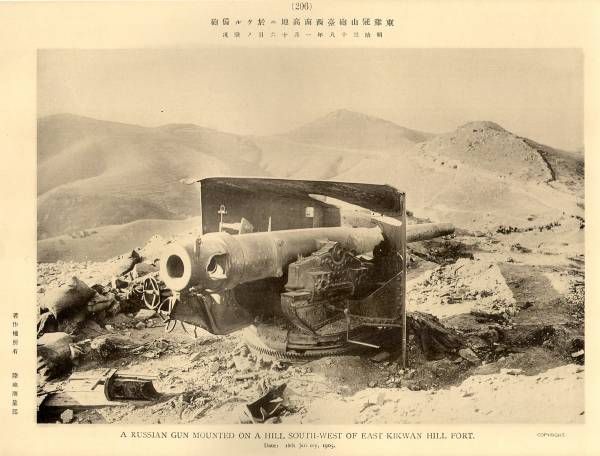 (207) Shelters on the old enceinte near Sungshu Hill.
(208) A machine gun on the old enceinte behind the
North Fort of Peiyin Hill.
(209) The Russian torpedo depot-ship "Amur" in dock
in the East Basin of Port Arthur.
(207) Shelters on the old enceinte near Sungshu Hill.
(208) A machine gun on the old enceinte behind the
North Fort of Peiyin Hill.
(209) The Russian torpedo depot-ship "Amur" in dock
in the East Basin of Port Arthur.
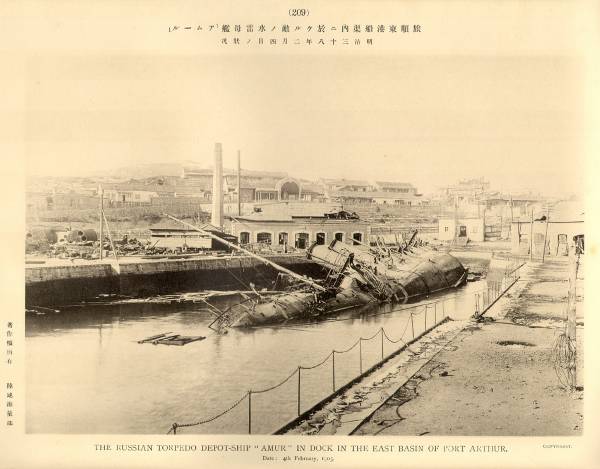 (210) The Russian battleships "Peresviet" and "Poltava,"
which were sunk by the Japanese.
(210) The Russian battleships "Peresviet" and "Poltava,"
which were sunk by the Japanese.
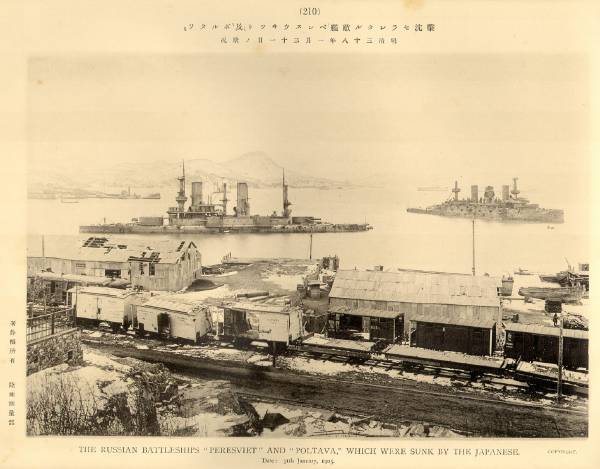 (211) A torpedo-boat found destroyed near the pier
of the Old Torpedo Station.
(212) Submarine mines collected on the east coast of
Heishakow.
(213) A torpedo-boat of the Japanese battleship
"Mikasa," which was burnt by the Russians on
the beach north-east of the Torpedo Station.
(214) A Russian gunboat destroyed and sunk off the
beach west of Weiycen Fort.
(215) A Russian torpedo-boat found destroyed near the
pier on the beach north-west of Kikwan Hill Fort.
(216) A dredging-vessel destroyed and sunk off the
beach east of the Old Torpedo Station.
(217) The Russian battleship "Retvisan," which was sunk.
(211) A torpedo-boat found destroyed near the pier
of the Old Torpedo Station.
(212) Submarine mines collected on the east coast of
Heishakow.
(213) A torpedo-boat of the Japanese battleship
"Mikasa," which was burnt by the Russians on
the beach north-east of the Torpedo Station.
(214) A Russian gunboat destroyed and sunk off the
beach west of Weiycen Fort.
(215) A Russian torpedo-boat found destroyed near the
pier on the beach north-west of Kikwan Hill Fort.
(216) A dredging-vessel destroyed and sunk off the
beach east of the Old Torpedo Station.
(217) The Russian battleship "Retvisan," which was sunk.
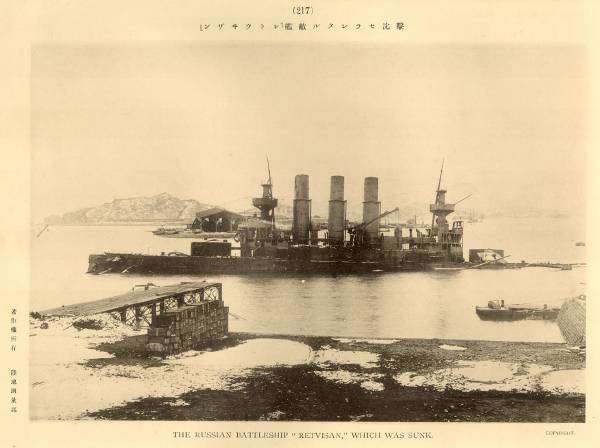 (218) The Russian cruiser "Bayan," which ran aground
and was destroyed on the south side of the East
Basin of Port Arthur.
(219) A view from Lanlzuying Fort of the boom near
t lie harbour entrance.
(220) The wireless telegraph station demolished on
Ilwangkin Hill.
(221) A view of the entrance of Port Arthur harbour
from field-works at the western foot of
Ilwangkin Hill.
(222) Wounded prisoners in the Depot Hospital at Port Arthur.
(218) The Russian cruiser "Bayan," which ran aground
and was destroyed on the south side of the East
Basin of Port Arthur.
(219) A view from Lanlzuying Fort of the boom near
t lie harbour entrance.
(220) The wireless telegraph station demolished on
Ilwangkin Hill.
(221) A view of the entrance of Port Arthur harbour
from field-works at the western foot of
Ilwangkin Hill.
(222) Wounded prisoners in the Depot Hospital at Port Arthur.
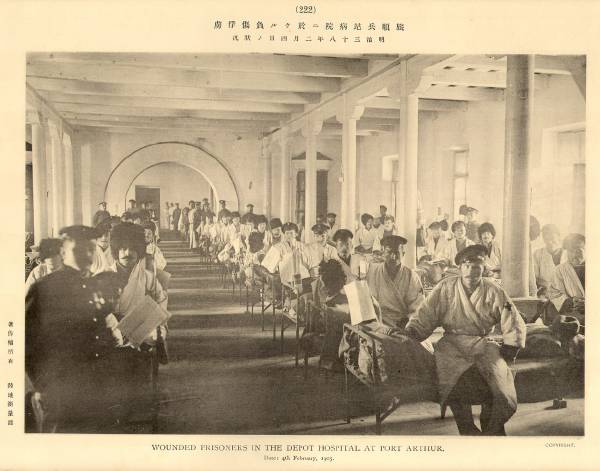 (223) Part of the New Town at Port Arthur.
(224) The favourite horse of General Stoessel.
(223) Part of the New Town at Port Arthur.
(224) The favourite horse of General Stoessel.
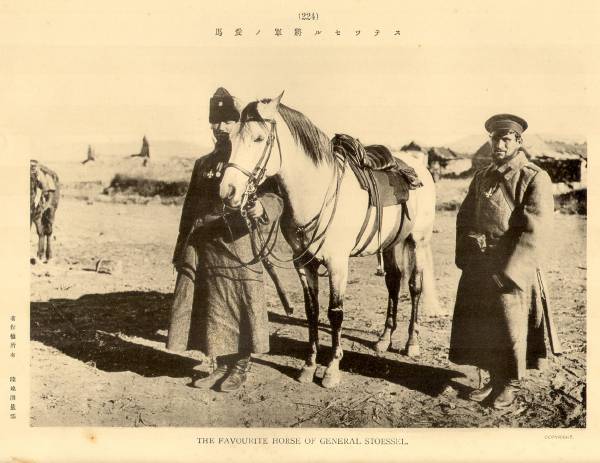 Colophon (Volume XIV)
Colophon (Volume XIV)
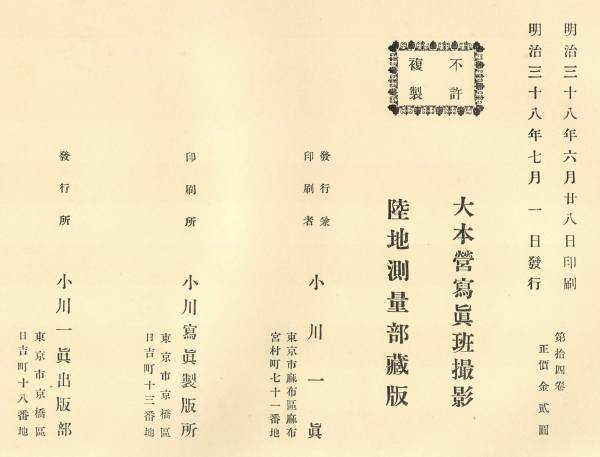 Printed Meiji 38 (1905).6.28
Published: Meiji 38 (1905).7.1
Printed Meiji 38 (1905).6.28
Published: Meiji 38 (1905).7.1
|

